#times or 4 times every game it can lead to some recurring problems that no one notices because it’s just a little tweak so he plays through
Text
Require Assistance Along With Your Games? Try out These Leading Tricks And Tips
Games are an incredible approach to have some fun or learn, with lifestyle-like graphics and appears to be that make you feel just like a genuine portion of the action. You can use your video gaming time and energy to holder up points taking out penetrating aliens or get ready for a university entry ways exam! Get more information with the subsequent valuable article.
Stay away from substance cleaners when cleaning away your video game disks. If your game disc is just not actively playing, you could be lured to use some type of window or windows solution on it. This could effortlessly problems the disc more. Get a delicate, free of moisture material and rub the disc clean from it instead.
To perfect a video online game, process all that you can. If you feel like you've utilized sufficient, end, breathe and after that practice more. Video gaming are a passion for numerous players, and when you expect to remain competitive on the internet, your skill units should be honed quite well.
When taking part in online games, make sure you go on a stretch out break 3 or 4 periods per hour. Your muscles and important joints are usually participating in recurring motions for very long amounts of time. In order to avoid muscle mass cramps and probable blood clots, you have to stretch out the muscles. This is certainly the best way to be healthy and play games.
Don't waste time in the coaching guide. Discover while you perform. The video game will be a lot more fascinating in the event you figure things out in the process. If you achieve irritated, you always have the choice of picking up the guidebook and turning by means of it for help. Try it out your self first, though.
Look for cheat regulations by carrying out a easy search online. Sometimes here is the number 1 place to find secrets and also other rewards for video gaming, without paying for any cheat guide. You can find out which requirements operate and those don't by undertaking a little research.
Understand the basic safety and information options of any gaming consoles in your own property. sv388 can find often parental management configurations to disallow youngsters from looking at doubtful content material. There might even be possibilities for you to individualize the manage options at the same time.
Well before allowing any "M" rated game titles at your residence, decide how outdated young children may be prior to they perform them. Contemporary consoles have the ability to steer clear of these types of online games with out a security password. Monitor your youngster at all times for a risk-free gaming encounter.
If you're a parent and you wish to know more in regards to what your kids are enjoying on the game systems, simply figure out the titles. When you are on the internet, you will discover the rating, some critiques, and several walkthroughs. These items will help you determine what your children are becoming into at every degree.
When you are a game player, consider buying a top quality tv which can give you an excellent exhibit of the game playing material. This is especially appropriate to people who often play sporting activities video games, as you will want to get the best from your visuals to increase your current game enjoy.
Question friends for suggestions. Better yet, think about requesting their children! You need to be able to get the game playing enthusiasts with your societal groupings, so use them to your benefit. Your pals know you and you believe in their viewpoints, so that you must be able to more easily pick new games to experience using their tips.
If you choose never to preorder (or simply neglected to), you may probably continue to gain the first day or two a game comes out. Many merchants bundle a freshly unveiled activity with a gift cards or certification well worth 15 or twenty dollars. This can make buying a new activity at launch less costly.
Keep a firm finances during the duration of the year on games. Video games can be a very pricey very good to get, which can cost you lots of money if things get free from management. Attempt to choose a number of video games and stay with all those, to lessen your current expenses.
Whatever your forte in gaming is, or exactly what the goal behind your play, there is certainly constantly something new to learn! With any luck ,, this article has launched you to a couple of new information and principles about video games that one could place to sensible use. With the a lot to supply, what's not to love about video gaming?
1 note
·
View note
Text
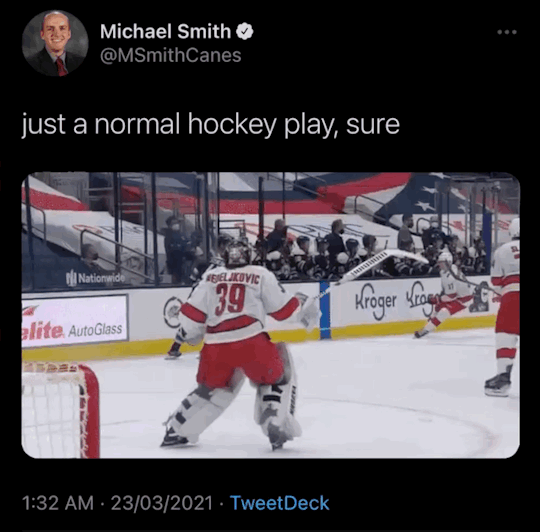
I’m still angry about this (and so many other uncalled things) 😤
#canes lb#andrei svechnikov#carolina hurricanes#honestly things like this make me so angry#like every game there are at least 4 or 5 situations like this where players from opposing teams cross check svech and don’t get called for#it while svech gets called for every stick infraction so how is this supposed to make him feel#and don’t get me wrong i’m not mad at any specific players for doing this when they get away with it because it’s the refs job to tell them#they can’t do that and the refs just don’t so the players play#and this shows how much the league cares about safety and keeping the stars healthy (and svech is a star player)#and i know worse things happen and don’t get called either and a cross check like that might not seem important but if it happens twice or 3#times or 4 times every game it can lead to some recurring problems that no one notices because it’s just a little tweak so he plays through#it and then suddenly one time he gets a serious injury from a regular cross check because it all adds up#and if anyone agrees with people on twitter saying canes need to add some muscle and this wouldn’t happen if someone stood up for svech and#that slavin and hamilton clearly don’t care about svech because they didn’t do anything about it do you think starting a scrap and taking a#penalty for it and putting your team on pk is what fixes this problem? how#the other team doesn’t have a reason not to cross check a player like svech if someone from the canes initiates a fight and gets penalized#for it because that gets them a power play so they either get svech rattled and banged up enough for him to not play 100% or they get a pp#out of it so tell me why wouldn’t they continue to do this as long as it works#if refs called those penalties players wouldn’t do that so often#i’m sure this applies to so many other talented players as well svech isn’t the only one getting cross checked left and right#anyway this has been a rant#sorry for going off#leaving it in tags so you don’t have to read it all#hope you’re all well 💕💕
90 notes
·
View notes
Note
can you please expand your thoughts on how aai1 handled turnabout ablaze? I noticed your (rightfully) low ranking of Alba earlier so I’m kinda curious about your opinion ^_^
Okay, before I go into this, I want to say: I love this game. I love all the AA games. Even the ones I have the most complaints about (this and DD) are wonderfully fantastic games with a fun cast and intriguing murder mysteries. You should play the ones you haven’t played yet, even the ones you’ve heard negative stuff about.
That being said, Turnabout Ablaze I think is sort of emblematic of every single problem I do have with AAI.
Ace Attorney Investigations is a little bit of a mess. At its best, it’s a fun murder mystery game with a stellar cast. It introduces Kay Faraday and Shi-Long Lang, it gives us more time playing as Miles Edgeworth, always a treat, and more time with my man Gumshoe. The mystery solving is fun and it offers a new kind of gameplay than the usual point and click style for investigations.
However, it also has a lot of weird pacing problems. Your new assistant and rival don’t show up until case 3 of 5. And Lang isn’t even in case 4, so he’s barely even a presence in his debut game, even though he’s a wildly interesting and fun character. All of his development is shoved into Turnabout Ablaze, and even though it’s welcome development, I kind of wish it was spread out more.
But going more into Turnabout Ablaze: It is long, arduous slog occasionally interrupted by some fantastic moments only to be dragged back down into the deepest recesses of hell. Its midpoint feels like a climax and everything past that point slowly and sadly peters away into a sad mess of one man slowly walking away from you to get on a plane.
To start with, this case in particular has so many different people being accused of murder. Kay, then Larry, then Shih-na, then Franziska, then Alba. AAI has this issue in almost all these cases, but it never feels as pronounced as it does in this one, this meandering, confusing mess of a case. It feels like we’re never really making progress, we’re just running in circles and occasionally hitting a brick wall while we get derailed from some bullshit or another.
I feel like the setup of AAI makes accusing people you care about far less impactful than it did in any of the other games, since that blame can be passed around so quickly and easily. Every single case has at least one moment where a recurring character gets accused, and it feels almost artificial? Like of course we’re going to have to care about Gumshoe and Maggey and Kay and Franziska and maybe not Larry but that’s a personal choice of mine. Yet most of those accusations never really last long enough to have anything meaningful happen plot or character wise, save for maybe Gumshoe in the flashback case? But there’s no tension to that one since we know Gumshoe ends up fine. The rest of the time it’s just an excuse to keep dragging Miles through a constantly meandering plot.
Also, there’re these weird distractions all over the place that lead nowhere. Having to deal with Larry and Oldbag for a few minutes hours even though it has nothing to do with the case at hand is annoying. If we got rid of that second murder, would anything have changed other than a few hours of gameplay? You just have to rewrite a few parts and boom, two hours of my life saved. Or the statue section, did we need to have that statue section? These would be well and good if they were fun to solve, or character building, but they weren’t. They were just there to add time to an already bloated final case.
Adding to that, I was not a huge fan of the Smugglers plot that they were pushing to be the overarching narrative. I feel like it was meant to be this big, intimidating force, but it ended up being so boring and impersonal. And boring. And did I mention boring?
You know what was interesting? Calisto Yew, betraying her friends. Calisto Yew murdering Byrne Faraday, and then Kay’s investment in hunting her down. Then you get to the big climactic showdown with Shih-na, and it’s amazing! It’s satisfying! We’ve been developing this Big Bad for three cases and watching her finally break down, getting to that reveal of who she was, the shootout, all of it was fantastic and wait, what was that? Shih-na didn’t do the murders for this case? She was just a cog in the machine? There’s more game? Oh. Uh. Right. Okay. Whoo.
Also Quercus Alba, uh, sucks? He sucks. He sucks so much. He’s boring and smug, but also he’s this nothing character. He sweeps in at the eleventh hour to be the final hurdle, but he had no buildup other than walking around in the background as this doddering old man we didn’t care about. It wasn’t even in a “Ooo he was always there the whole time” way that Shih-na had, it was just this boring old man doing boring old man things.
And then they have the audacity to make the final confrontation with him last for HOURS longer than it needed to. And every single time it feels like we’ve progressed, not only have we made no progress, but we are actively slamming ourselves into the same brick wall over, and over, and over again.
“Oh, you see, Miles Edgeworth, I have ✨Diplomatic Immunity✨!”
“Ah, well, how about this proof! Proof that you are involved with the smuggling ring! What do you think about that?”
“Well, what do you think about this ✨✨Diplomatic Immunity✨✨ that I still have. Oh well time to go on a plane—”
“Wait! Wait Quercus Alba, what about this new proof! This proof that you could have done the crime!”
“Wowie, my ✨✨✨Diplomatic Immunity✨✨✨ certainly thinks you’re making an interesting point.”
And then Lang shows up to get rid of his ✨✨✨✨Diplomatic Immunity✨✨✨✨ after we’ve been in the same fucking time loop for what feels like twenty years of my life and then suddenly we have to prove without a shadow of a doubt that Alba did the murder?? Why???? That’s not how it works?????? Can someone fucking ARREST THIS MAN???? GUESS WHAT GUYS YOU DON’T NEED TO PROVE HE DID IT YET, YOU HAVE MORE THAN ENOUGH TO ARREST HIM YOU’RE NOT IN COURT?????????? END IT!!!! PLEASE!!!!! JUST END IT!!!! FUCK!!!!!!!!
I don’t care about the Smuggling Ring! It’s this weird nebulous idea that has no real bearing on any of the main characters other than Lang. And also like “Oh no, my country’s economy is in shambles” that’s so????nothing???? Again, if we could have anything tying us to the importance of improving Zheng-Fa’s economy maybe that would be different. Human beings as a species don’t really connect that well to a macro level if there’s nothing to make it feel personal, you know? We know nothing about Zheng-Fa and have no connection to Zheng-Fa, and we don’t have any way to conceptualize Lang’s struggle in a way that holds any meaning. Sure it’s important, but it’s not dire to us, and that makes for a shitty confrontation!!!
Let’s look back at the other final cases in this series. AA original: Miles is in danger. His smug mentor is not only trying to get him killed, but did the killings himself. AA2: Maya is kidnapped. It’s a struggle between your ideals of finding truth and justice and making sure your best friend isn’t killed. AA3: Maya is missing, and then later, suspected of murder. You’re confronting this big bad who's been a problem from case one and then also proving yourself to Godot.
They’re all personal stakes. They all matter to the main character, and the bad guy had a DIRECT hand in why. And yes, Alba ordered the killings, but again, it’s so impersonal, it’s like three steps removed so as rendered meaningless. Then you add on top that he’s got no motivation, other than greed and power I guess, he’s not fun, considering how many circles he makes us run in only to get to the same problem every single go around, he’s barely a character, he—!!! I hate him!!! I hate him and not in a fun way!!! Just end the case!!! Please Capcom!!!!
Again, the first half? When we were building to that confrontation with Shih-na? Great! Climactic. Fun. Interesting. But the rest? So deeply incredibly frustrating.
Sorry this was longer than I meant for it to. But I’m not too sorry. After all, I have ✨✨✨✨✨Diplomatic Immunity✨✨✨✨✨
41 notes
·
View notes
Photo

Top Ten #3 - World of Final Fantasy (Vita)
"Why is this game here? How is it this high up the list? When did we get to this point? What the fuck is the deal?" I can hear myself and everyone else asking.
If there was ever any expectation of this list being at all objective in terms of game quality, then World of Final Fantasy completely shatters that notion, being at most a 7/10 game (leaning more 6 than 8). It's a Pokémon clone; a monster catcher RPG with a generic kiddy animu story, chalk-full of jokes and tropes that you must've seen a thousand times if you've ever glanced at a shonen anime. However, while at first it appears to be an uninspired cash-in, as Squeeenix attempts marketing to kids that might not've owned a Nintendo handheld in 2016, it achieved something else entirely: it made me happy.
It's RARE for a piece of media to have that impact on me; I might be entertained and have fun, fall in love with the story/characters/setting/artstyle; but to actually make me happy, that is a herculean feat. And it's no mystery why: I was a Final Fantasy fan for years, have now played all main series titles pre-XV (sans the MMOs and Lightning Returns); I adore turn-based RPGs, especially if they aren't a real-time hybrid or ATB-like; and since I have a collectonist playstyle, the inherent aspect of Pokémon games (gathering all the critters), reskinned with stylistic interpretations of several creatures in the FF franchise in the form of 'Mirages', immediately appeals to my sensibilities. Even as I replay it at time of writing, that love hasn't faded, and this is why, while a 7/10, WoFF is one of my personal 10/10 games.
But I think it's because of the simplistic story that this game shined so brightly. Lann and Reynn, the ginger twins that lead this adventure to catch 'em all, have the necessary elements than one should hope are present in these types of stories, and the rug isn't so much pulled from under your feet later on, but more that you're incentivized to push it aside and see what lies beneath. Sure, it relies on the recurring FF tropes of clueless protagonists and killing god-like entities, but it managed to take characters and elements from (almost) all of its previous games and present them in a new light. Awkward at best, but it's not shocking to see the new roles attributed to old characters, all in the shape of chibi vynil figurines called Lilikin. For fuck's sake, it has the only version of Claire 'Shaitning' Farron that I actually liked, as she manages to fucking emote and interact with others in an enjoyable fashion, rather than an automaton pretending to have human emotions.
That being said, WoFF is a perpetual give-and-take:
1) Until the post-game, Lann and Reynn are obligatory choices for your team, with the ability to change between Jiant (L size) and Lilikin (M size) forms. The stacking mechanic is a great way to justify using more than one Mirage in combat, and different Mirage stacks will give you access to different combos and abilities, therefore taking the limited action slots from Pokémon games and blending it together with the inherent growing list of skills from FF games. This means that you're less inclined to overutilize certain Mirages to deal with specific enemy teams and bosses (as it's how prepared you are beyond just your setup that will determine your success) and experiment; but the game's difficulty curve is all over the place (yet rarely a challenge), and you'll find yourself taking frequent pit-stops to the Prismarium, be it for imprisming Mirages, recharging your VERY limited AP, handling specific challenges, or just solving puzzles that require the use of HM-equivalent field abilities.
2) The chibified artstyle translates classic and more recent creatures in Final Fantasy to have a consistent look AND be desirable to collect (same couldn't be said of FFXIII-2); but there's several reskins for some Mirages which, while offering different abilities and attributes, still look the same. Kinda like shinies, but without the bragging rights. Since you can transfigure Mirages as long as you have met the necessary prerequisites, and without meta alterations in stats, collecting them will be far more expedient, yet you'll end up leveling a lot of creatures with far less personality than most Pokémon you catch, even if you don't have to worry about chasing the top percentage of Chocobos.
3) Pokémon has always been more oriented towards community/multiplayer gaming, but WoFF is unquestionably a single-player experience, with all Mirages available for you to get eventually, and the closest thing to 'Legendaries' being XL Mirages, which take the roll of Summon-equivalents for you to play as (rather than a single-skill mega ability); however, the action-activation to imprism (catch) can sometimes be completely asinine, if not incredibly vague, and the memento items necessary to transform certain Mirages can be attained only by the most awkward of means.
4) Even what at first might seem to be optional aspects of the game are utilized in the story and overall gameplay, and I appreciate that mechanics introduced have a reason for being there, for both story and play. What I don't appreciate is how the story grinds to a halt because you have to partake in ridiculous minigames to progress, or because the writers gave up on how to insert specific interventions within a cohesive narrative, and just said "Fuck it, do this as sidequests in the Tardis Tearoom. We couldn't be bothered to have you revisit every zone in a natural way".
I could go on how the game isn't as optimized as it should be, that mechanically it stumbles and lacks in quality-of-life improvements. And while you can get immersed, either the kiddy story or a lack of long-time investment in the FF franchise might prevent most from getting into WoFF as much as I did (and believe me, those things ARE there and they ARE a problem). But I'm not here to deny the faults, I'm here to explain why I like these games. It's cheezy, but I love this game, warts and all. It had no right to be as fulfilling as it was.
If you're a Poké-fan and want to give WoFF a chance, always remember to first consult with your local RPG aficionado, to make sure it's right for you.
#art#artists on tumblr#world of final fantasy#Final Fantasy#reynn#lann#tama#top ten#fanart#illustration#videogames#print
39 notes
·
View notes
Link
https://ift.tt/3l39LwX #

Sam Raimi’s Spider-Man trilogy redefined the superhero genre and the summer blockbuster. The three films provided audiences with a sense of escapism unlike anything they had seen before, thanks to its heart-pounding action scenes and collection of beloved characters.
RELATED: Spider-Man Villains Ranked Least-Most Likely To Win The Hunger Games
Peter Parker, his friends, and his foes all got many chances to show off their abilities on the big screen. Indeed, the trilogy’s characters star in some of cinema’s most unforgettable moments. From upside-down kisses in the rain to heartfelt monologues about the responsibilities of a hero, Sam Raimi’s trilogy has plenty of scenes that rank as some of the most memorable in cinematic history.
10 Eddie Becomes Venom

To say that Topher Grace’s depiction of Venom is unpopular would be an understatement. In fact, most fans agree he was one of the things Spider-Man 3 got wrong. That doesn’t mean his character didn’t have some thrilling moments on-screen, though.
Eddie’s most memorable scene in the movie is his transformation into Venom. As Peter gets rid of the symbiote while in a belltower, the alien falls and lands on Eddie, quickly overtaking him. A killer soundtrack and fittingly gloomy atmosphere accompany the transformation. And even if Eddie ended up being an underwhelming villain, his conversion into Venom is definitely memorable.
9 Flint’s Confession
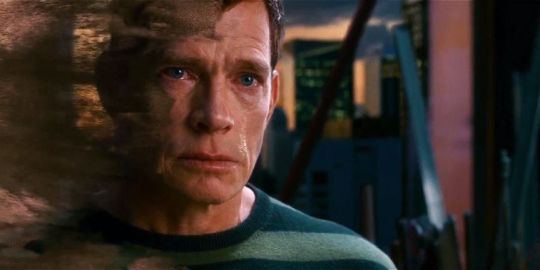
Every fan knows that Spider-Man 3 has way too many villains. None have enough room to shine or prove themselves as worthy heirs to Goblin and Ock’s legacies, but they still get some redeeming moments. In Sandman’s case, it’s his final monologue to Peter, where he confesses his guilt about the part he played in Uncle Ben’s death.
Enhanced by Thomas Haden Church’s performance, the scene succeeds in providing some much-needed closure for Peter. Sandman is less a villain and more a tragic figure of circumstance, and his confession to Peter confirms it.
8 Goblin’s First Flight
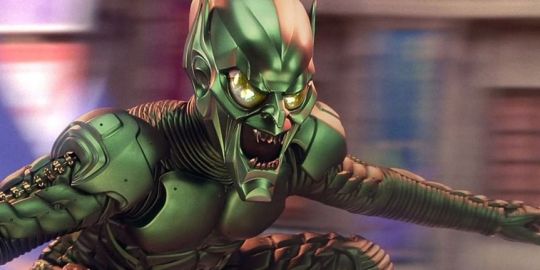
Willem Dafoe redefined what it means to be a comic book villain. His take on the Green Goblin is the perfect mix of over-the-top and seriousness, adding a sense of gravitas that overcomes the more cartoonish aspects of the role.
The character has plenty of memorable moments in the first Spider-Man movie. However, his initial confrontation against Spider-Man during the World Unity Fair will go down in cinematic history as one of the best action scenes of all time. It is fast-paced and thrilling, wasting not a single moment of its four-minute length. The Goblin gives an impressive display of his powers, proving that he will always be Spider-Man’s best villain.
7 Otto Octavius’s Sacrifice

Sam Raimi’s first two Spider-Man films succeeded because of how much they fleshed out the villains. They weren’t just CGI creations trying to take over the world, but three-dimensional characters with ambitions and limitations of their own. Spider-Man 2‘s Otto Octavius is one of the genre’s most compelling villains, one who succeeds in winning the audience’s sympathy while remaining a fearsome threat.
RELATED: 10 Things Only Comic Book Fans Know About Doctor Octopus
During Ock’s final moments, he sees the error of his ways and decides to go down with his creation. Proclaiming he will “not die a monster,” Octavius sacrifices for the greater good. Thanks to Alfred Molina’s committed performance, the moment is one of the trilogy’s most memorable, cementing Octavius as one of the genre’s most complex characters.
6 J. Jonah Jameson Saves Peter Parker
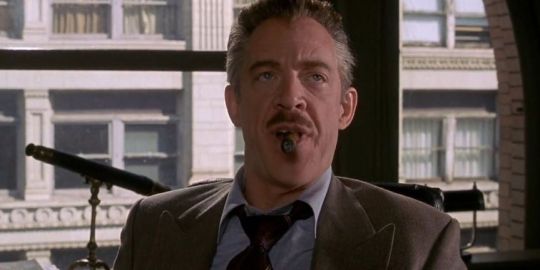
J.K. Simmons as J. Jonah Jameson is the very definition of spot-on casting. The actor took an already well-known character and translated him into the screen seamlessly and faithfully. Throughout his tenure in the trilogy, he gets plenty of comical moments, but his most memorable is his protection of Peter Parker.
When the Green Goblin blasts into the Bugle’s offices, he threatens Jameson and asks for the name of the photographer who takes Spider-Man’s pictures. Jameson refuses to tell on Peter, telling the Goblin the reporter sends his stuff through the mail. The scene shows a new and unexpected side to JJ, a glance at the empathy he works so hard to hide.
5 Uncle Ben’s Lesson
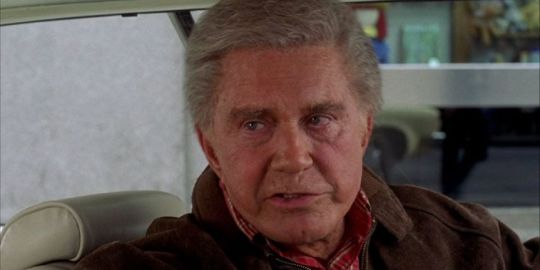
Uncle Ben’s death is one of the defining moments in Peter Parker’s storyline. It’s the first of many (many) tragedies to happen to the character, inspiring him to become a hero in the first place. Sam Raimi provides enough room for Uncle Ben’s character to develop before arriving at the inevitable conclusion.
Cliff Robertson’s heartfelt monologue summarises the essence of Spider-Man. “With great power comes great responsibility” has become one of the most enduring phrases in pop culture, adding a more profound layer to Raimi’s trilogy. And while Uncle Ben has little screentime, his presence remains throughout the entire trilogy, thanks in large part to his now-immortal words.
4 Aunt May’s Advice

Rosemary Harris remains the most compelling and memorable cinematic Aunt May. She imbued the role with plenty of warmth and empathy, avoiding the one-dimensional approach of subsequent movies. Harris’ Aunt May wasn’t just another peripheral character; on the contrary, she was Peter’s anchor, a constant source of inspiration for both the boy and the hero.
Her role as Peter’s guide is blatantly clear during her monologue in Spider-Man 2. While she packs her things to move out from her house, she talks to Peter about the nature and importance of heroism. Her speech is the gentle push Peter needed to understand the true role of his superhero counterpart. It’s a sweet but unforgettable moment that confirms Aunt May’s importance in the friendly neighborhood Spidey’s life.
3 Goblin’s Last Flight
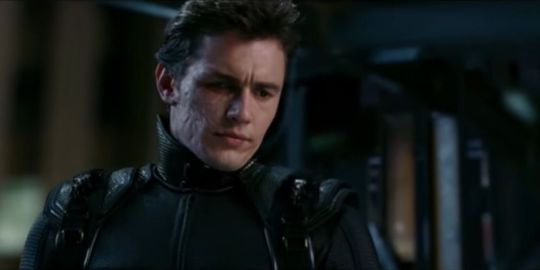
Throughout the Raimi trilogy, Harry Osborn suffers almost as many ups and downs as Peter himself. The loss of his father leaves him devastated and desperate to find someone to blame, leading to his descent into the Green Goblin persona. Alas, Harry was never his father, and he proves it at the last moment.
RELATED: 10 Most Powerful Variants Of Green Goblin In Marvel Comics
Sporting the Goblin costume, Harry goes to help Peter fight Venom and the Sandman. The two confirm their friendship, and Harry bravely dies fighting the enemies. Harry’s sacrifice continues the recurring theme in the trilogy that every victory comes with a steep price. It’s also a perfect send-off for the character and a way to restore the Osborn legacy.
2 Mary Jane’s Upside-Down Kiss
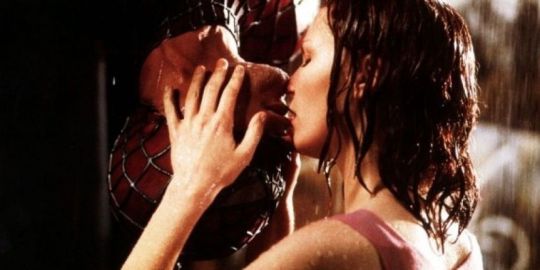
For all its strengths, the Raimi trilogy has one undeniable flaw, and that’s its treatment of Mary Jane Watson, Peter Parker’s main love interest in the comics and most movies. The character barely received any development beyond her damsel in distress role. Still, Mary Jane is a crucial figure in superhero movies; she defined the “superhero girlfriend” role for better and worse.
Out of all her moments in the trilogy, Mary Jane’s most memorable is her upside-down kiss in the rain with Spider-Man. It’s not only one of the most iconic scenes in modern cinema, but a perfect summary of MJ and Peter’s relationship. The setup may seem a tad outdated under a 2021 eye, but Kirsten Dunst and Tobey Maguire’s chemistry is so electric that fans can let go of the more dubious elements of the scene and enjoy the romantic aspect.
1 Spider-Man Stops A Train
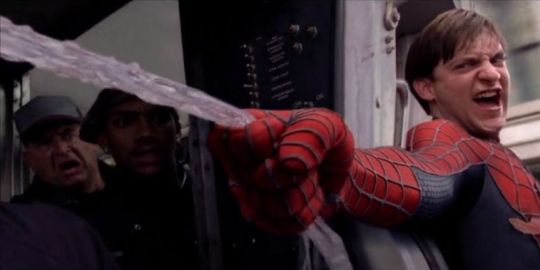
Tobey Maguire’s Spider-Man remains as beloved now as he was back then. His take on Peter Parker gained new life thanks to the internet; indeed, Maguire’s Spidey is the king of memes, from Bully Maguire to the now-iconic “I missed the part where that’s my problem.”
However, this Spider-Man remains a blueprint for cinematic superheroes, thanks to his many heroic moments on screen. None is more memorable or inspiring than his efforts to stop a speeding train in Spider-Man 2. The scene works not only as an action setpiece but as a demonstration of Peter’s strongest power: his perseverance. Peter will never stop trying, even if all the odds are against him. Spider-Man is so relatable because he makes multiple mistakes and spends his time trying to fix them. But the point is, he will always try, and the train scene is the perfect representation of Spider-Man’s essence.
NEXT: 10 Unpopular Opinions About The Sam Raimi Spider-Man Movies (According To Reddit)
#marvel #avengers #marvelcomics #spiderman #mcu #ironman #comics #captainamerica #thor #avengersendgame #marvelstudios #xmen #dc #marveluniverse #art #cosplay #tomholland #hulk #disney #comicbooks #dccomics #peterparker #tonystark #blackwidow #marvellegends #endgame #deadpool #marvelcinematicuniverse #loki #bhfyp
The post Sam Raimi’s Spider-Man Trilogy: Each Main Character’s Most Iconic Scene appeared first on undertheinfluencerd.net.
#entertainment, screenrant #tumblr #aesthetic #like #love #tumblrgirl #follow #instagram #photography #instagood #likeforlikes #s #likes #art #cute #o #girl #followforfollowback #a #tumblrboy #grunge #fashion #photooftheday #tiktok #l #photo #sad #k #frases #f #bhfyp
2 notes
·
View notes
Note
Hi Indy! I know Arkhamverse Riddler is definitely your specialty. Do you happen to have a rough ranking of Riddlers that you like from most to least? And which do you think is the most definitive version of the character?
I THINK that’s what my blog description says, anyway
Yes, at all times I have a rough ranking floating around in the back of my mind. It is going to be very long so I will answer the last question first.
For most definitive version of Riddler I’m going to have to go with BTAS. No recurring villain really had a distinct personality from their original (1940s) version, and while I am not knocking Frank Gorshin the 1966 Riddler absolutely was a bit Joker-y. Most importantly (if I am not mistaken, which I could be), BTAS gave Riddler what became his most important trait: his intelligence. Before that he was mostly an average weirdo who wore a green suit (sometimes) and liked riddles and sometimes built puzzle traps. After BTAS, though, the Riddler’s intelligence became the driving force of his character. Batman ‘66 saved Riddler from obscurity, but BTAS made him both relevant and future-proof. Will we ever see a Riddler of average intelligence who doesn’t specialise in computer programming/engineering ever again? I doubt it, and that’s because of BTAS.
Onto the list. It does not include EVERY Riddler ever because I have not read every Riddler story ever, but it should cover most of them (or at least the ones you’ve probably heard of).
1. Anything Paul Dini wrote. This actually covers a few different Riddlers, which would be the first two Arkhamverse games, the most notable PI Riddler stuff, and of course the Riddler from BTAS. Paul Dini can write the Riddler as both being a bad person and sympathetic at the same time, which is actually harder to pull off than it sounds. AND he does it without using backstory as a crutch, which really is hard.
2. Jeph Loeb/Jim Lee’s Riddler from Hush. He only actually appears for two issues, but it’s one of the best Riddler stories merely because it allows him to do all the things Riddler SHOULD be able to do, but can’t because then there would be no Batman comics because he would have ended them. 619C is also, in my opinion, the best Riddler cover of all time.
3. Jim Carrey’s Riddler from Batman Forever. Why would I put him this high on the list, you ask? Because some writers forget that the Riddler is half just in it to have a good time and he doesn’t really care about how other people perceive him. This man is living his best life and he’s doing it in glittery spandex and a light-up jacket. Is he over the top? At the time, no, not really. At the time Riddler kinda just acted like that. And he should be able to do so, in my opinion.
4. Current Riddler (James Tynion IV). While this Riddler has some issues with consistency (though this probably has to do with being shuffled from a main comic story into a Catwoman story), he returns to being almost self-cripplingly paranoid and absolutely losing it when he’s bested, which I think are important traits for Riddler to have. I’m also actually really amused that they gave him the Batman Forever hair.
5. Batman ‘66. While it did likely rescue Riddler from pending obscurity - he actually never appeared in a Batman comic before 1965, and before that was featured in only two issues of Detective Comics - and he definitely checks the ‘charming’ and ‘having fun’ boxes, there isn’t a whole lot differentiating him from the Joker he’s playing alongside. If you watch the Batman ‘66 movie they’re almost the exact same character, just one likes jokes and the other likes riddles.
6. Hush Returns and its aftermath. This stuff is weird and doesn’t make a whole lot of sense because it mostly involves Riddler running away from Hush and retcons certain things from Hush, most importantly the part where Riddler got everyone to work together because he gave them what they wanted. Hush Returns (which also contradicts itself during the story) for some reason has everyone angry at Riddler for tricking them and it ends with him getting the shit beat out of him and puts him into a coma for a year, which leads into him getting total amnesia and becoming a PI. That’s the reason it’s so high on the list. The story is weird and makes no sense at all for any of the other characters in it either but it gave us a reason for PI Riddler and that makes it matter. Sort of.
7. Brave and the Bold/The Batman Riddler. I’m putting them both together mostly because BatB Riddler features in I think only one episode and he deserves a mention because he’s adorable. TB Riddler was an interesting experiment into a Riddler that, for whatever reason, never really came into himself as a person and instead sort of enacts revenge for his existence on life. If I remember correctly he’s also pretty low-key about his intelligence, which is another interesting character choice. I respect the things they went for but this Riddler overall gives me the impression of a person who always says no when invited to something but gets upset when people stop asking which, while definitely something the Riddler would do, isn’t really my preferred take.
8. Snyder Riddler (New 52). The problem I have with this Riddler is that I have no idea what his motivation even is. I was told a long time ago that a backstory for him WAS written but didn’t make it into Zero Year because the story was already too long, which is... not a great look for a professional storyteller. And because we don’t know anything about this Riddler, this story consists of a dude who wears green to impress women (which he never shows any interest in), gets the mob to work for him... somehow... and decides to spend a YEAR watching the people in Gotham die because... I’m not sure? If it amused him, sure, I could understand that. But he just seems super bored during the entirety of the story. He doesn’t even seem particularly excited when Batman actually shows up in front of him. Beyond Zero Year his appearances are, to my knowledge, limited mostly to two issues in Batman Eternal, where he’s hiding, three issues of The Flash, where he speedruns Zero Year and is undone by the Flash villains teaming up against him (which I don’t know enough about Flash villains to comment on), and Scarecrow 23.2, where he for some unexplained reason seems to look up to Scarecrow. And then there’s Detective Comics: Future’s End, which is just the worst thing ever. Snyder didn’t write all of these stories, but they are based on his Riddler.
9. Gotham Riddler. I didn’t watch past season 3 so I can’t comment on too much after that, but the arc with Mad Grey Dawn and ‘I knew that you knew that I knew’ was some of the greatest Riddler stuff we had gotten in years and if they had just kept on with that they would have had one of the greatest Riddlers of all time.
10. Jeph Loeb/Tim Sale Riddler. Full disclaimer I haven’t read Catwoman: When in Rome, but I have read The Long Halloween and Dark Victory. The reason I don’t like this Riddler is because he actually bears no resemblance to him. He’s a literal moron who just stumbles around incompetently for the duration of his relevance to the plot. It’s like they decided to make an ironic Riddler who is actually stupid and also for the first time in his life does not have the ability to locate a tailor. I don’t actually understand the point of this Riddler’s existence. He isn’t even really Riddler, he’s just some sort of vaguely Riddler-coloured person.
11 notes
·
View notes
Photo
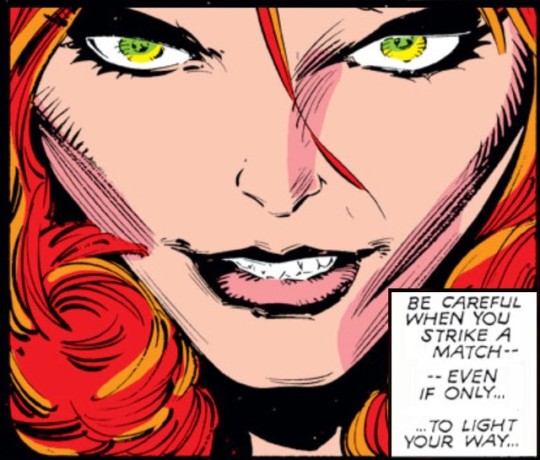
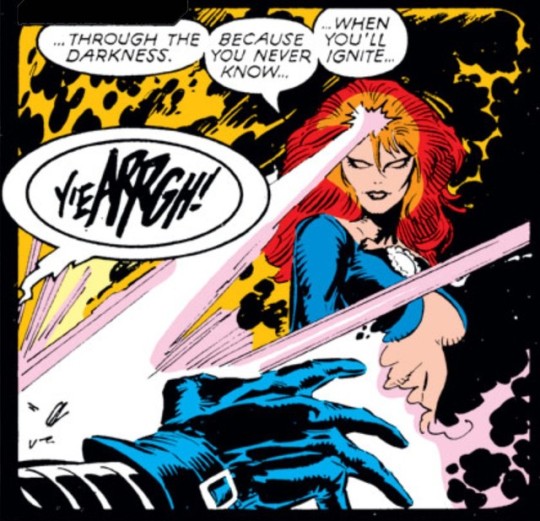
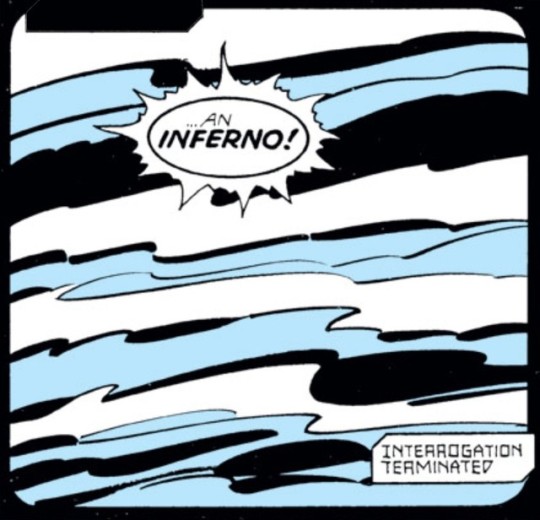
Review: The Claremont Crossovers
Geez, I haven’t written a review for this blog since my Secret Wars review from like 17 years ago. How can that be? Well, I guess I used to work on this blog a lot more often and now I’ve gotten way more into Super Nintendo games and BDSM. Like a lot of people. But now that I finally finished reading Inferno, it is time once again to bookend my experience with an overly wordy wall of text filled with the worst kind of oblivious meninist butt humor jokes and pretentious sounding run-on sentences that are trying to sound smart but are always improperly ended with prepositions of. And lots of ridiculous comic book panels.
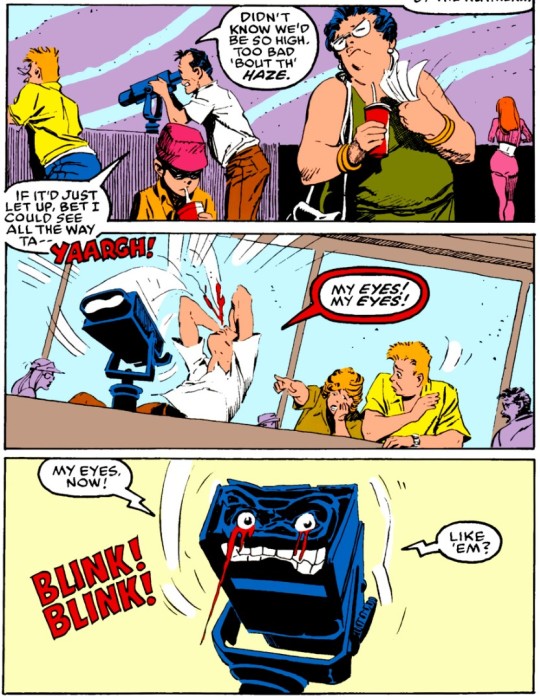

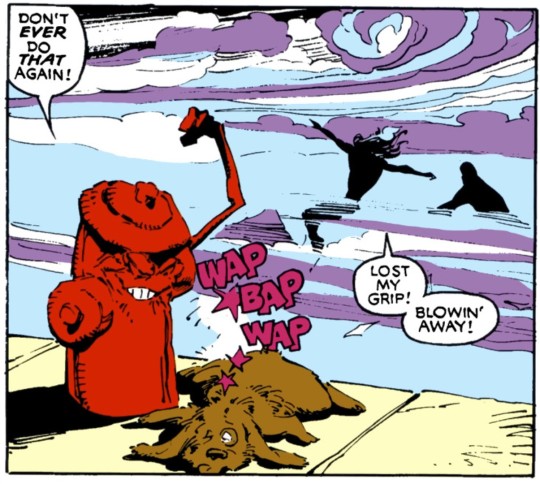
These are only the silliest panels from this reading that I could find after looking for about 25 seconds.
Bookeeping. This review covers everything that I have read since X-Factor #1. This includes Uncanny X-Men #204-243, X-Factor #1-39, New Mutants #38-73, along with a smattering of annuals, Daredevil, Power Pack, Fantastic Four, Spider-Man, Excalibur, and X-Terminators comics that were all part of the Mutant Massacre, Fall of the Mutants, and Inferno crossovers. There were a lot of developments over the course of the 4 years these comics were published. Jean Grey was resurrected and the original members of the X-Men reformed under the moniker X-Factor.
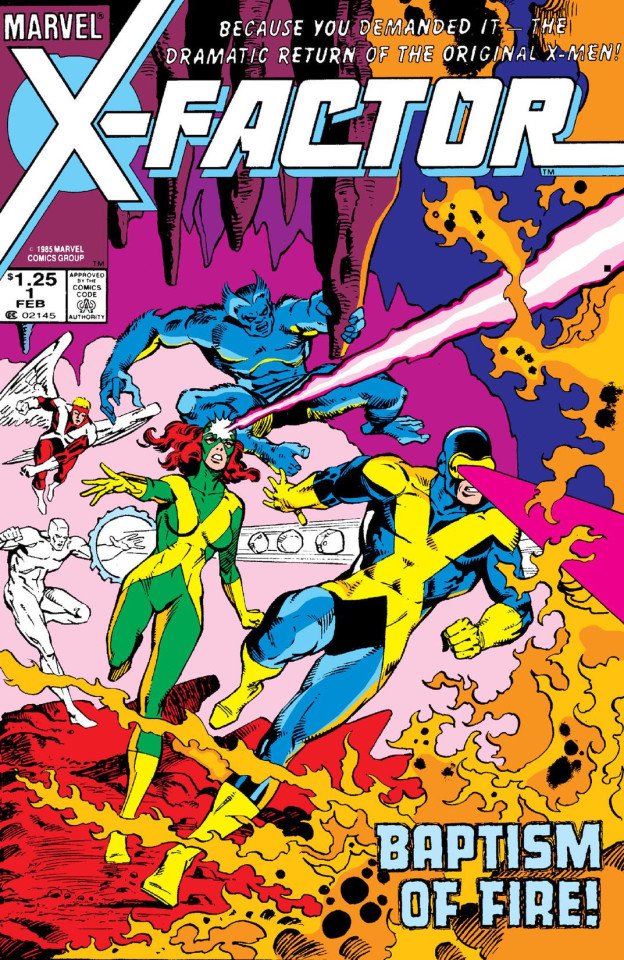
Mr. Sinister formed his band of evil mutants, the Marauders, who would become the X-Men’s main antagonists, and their most devious act would include committing mutant genocide against the Morlocks in the New York City sewers while dealing critical wounds to main X-Men team members Kitty Pryde, Nightcrawler, and Colossus during the fight.
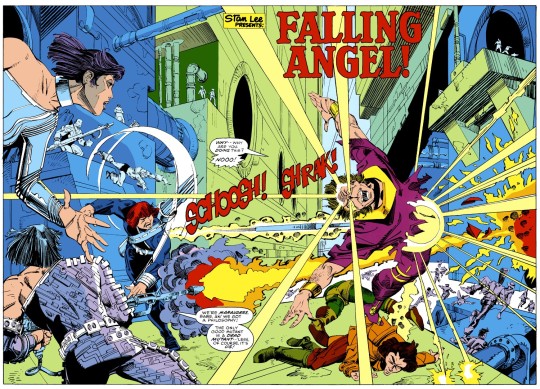
Later, the X-Men were seemingly killed in a struggle with the mystical being known as the Adversary, but in reality they went into hiding in their new Australian outback base.
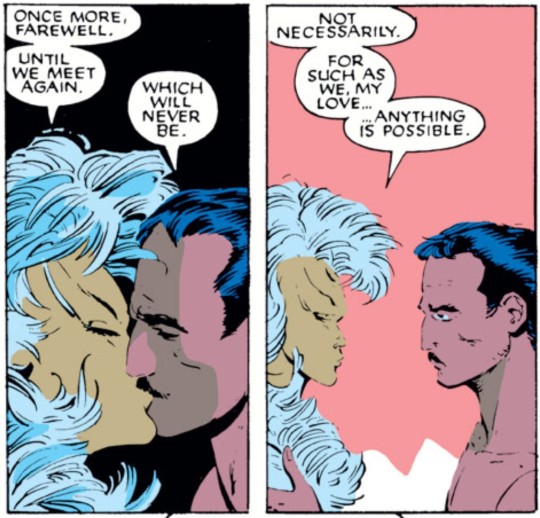
Illyana Rasputin lost control of the hell dimension Limbo which led to a demon invasion of Manhattan.
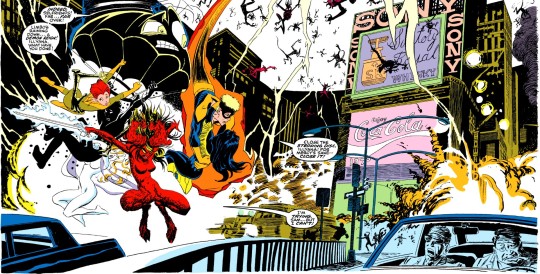
And finally, perhaps most prominently, Cyclops left his wife Madelyne Pryor and their son to get back together with Jean Grey, an act that led Madelyne to become corrupted with Pheoenix Force power and to turn into the Goblin Queen.
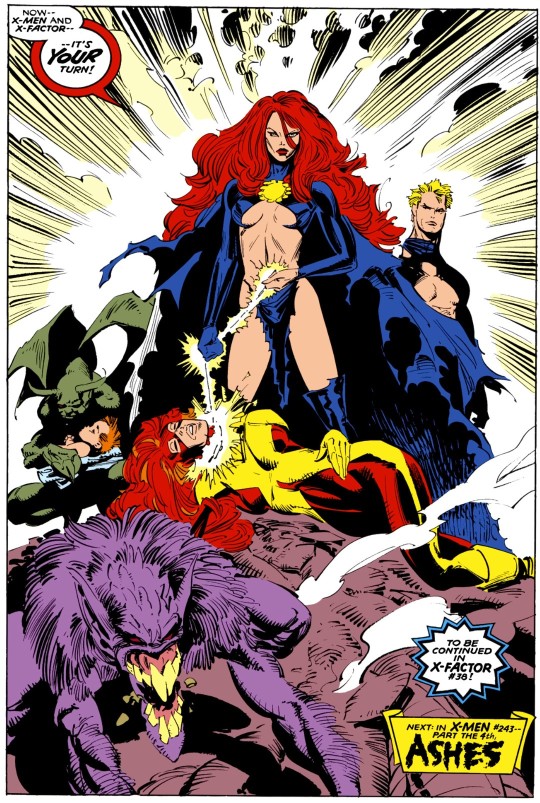
This era of X-Men comics contains the first major crossovers between the main X-Men comic book and its spinoffs. These events would become common as Marvel found ways to use its more strongly published works to carry the weaker ones, and the ploy still works apparently since here I am 30 years later reading 500 page omnibus collections just because there are 4 or 5 absolutely killer X-Men comic books in them. I love the X-Men so much that I’m willing to wade through the unending buildup to get the most out of the climaxes.
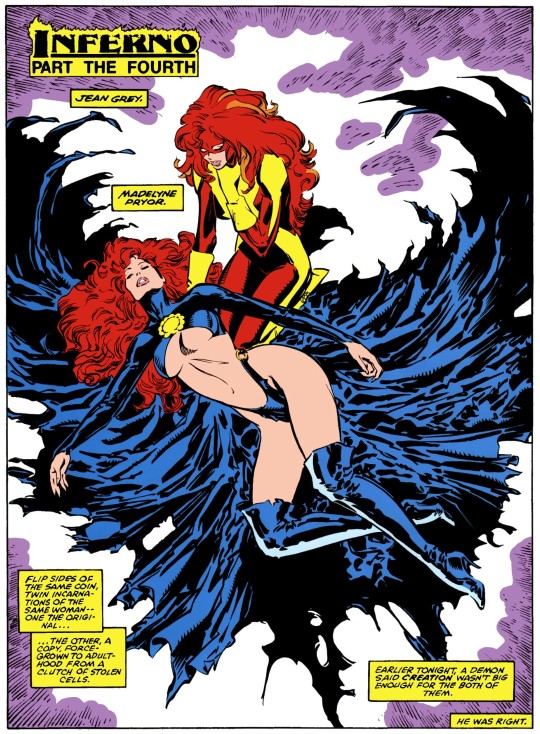
Seriously this artwork.
However, I find that this style of editing leads to a peculiar trend in pacing that can be tough to recover from in-between the major storylines. As Mutant Massacre leads into Fall of the Mutants, which then leads into Inferno, the characters are faced with consistently increasing stakes. With each passing story line, casualties grow and become more grave, and the consequences are more lasting. Mutant Massacre starts with the genocide of a mutant community, and several main characters are critically wounded as the X-Men face the worst defeat they’ve ever experienced. Then a year later in Fall of the Mutants, just as the team is starting to recover, the entire team of X-Men is killed during their battle against the Adversary. They would immediately be resurrected as a reward for sacrificing themselves to save the world, but it is still a defeat that claims the lives of every member of the team, if only for a moment. By the time we get to Inferno, the world is literally ending. Demons are raining from the sky and regular people are straight up getting slaughtered in the streets and elevators as the X-Men are more or less helpless to stop the destruction.

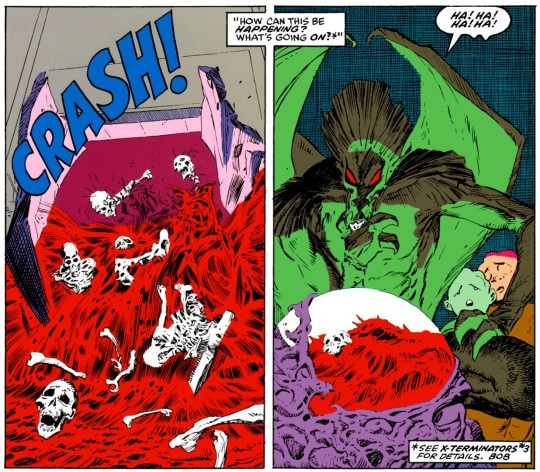
Inferno is an amazing storyline, if only for all the scenes of inanimate objects coming to life and straight up eviscerating common folk who are just minding their own business. Look at this shit!!! How did the comics code of conduct ever approve this. A mob of people just packed themselves into a demon FOOD PROCESSOR and every inch of them was liquefied except their bones. Chilling. (And let’s just forget about how the writers retconned all this blood orgy stuff in the Inferno Epilogue).
This all works in a capitalistic sense. Constantly raise the stakes and don’t let up for a second because if you do, the reader will take their eyes off the page and you will lose money. But the problem is, you can’t do this forever. And if you try, eventually you are going to write yourself into a corner where you’ve raised the stakes so many times, and you’ve re-manufactured the drama so often, people will stop caring. I call this the Dragon Ball effect.
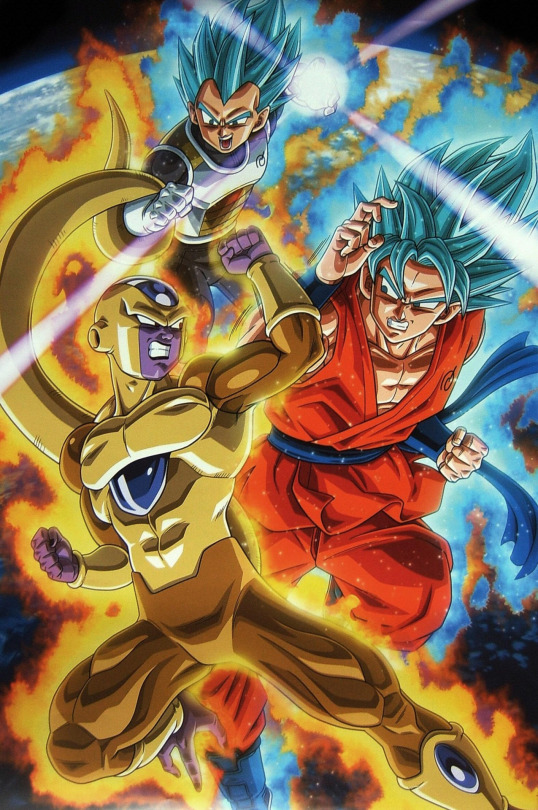
How many times have these characters become gods at this point? Like three movies ago, the most recent movie was literally called “Battle of Gods.” I’m not even watching Super. Once your characters get so far away from humanistic stories people can relate to, you are no longer creating art. You’re manufacturing sensationalism. And it gets boring. These guys are starting to look like different flavors of freezie pops.
Maybe this is why the X-Men comics that come after this, the comics that make up the last leg of writer Chris Claremont’s 17 year run on the series, become so weird. Because perhaps there was no way to continue to raise the stakes any higher. After this point, we don’t get any more big crossovers until X-Tinction Agenda, but even that story is small and quaint when compared to what is presented here. Wolverine completely disappears from the series, all our other favorite characters disappear into the Seige Perilous to be transformed into completely different versions of themselves, and we get a lot of surreal stories that don’t have any sort of climax in the way that we’ve been conditioned to expect. The series becomes murky and ambiguous, without a solid narrative arc, and I think that’s why people regard the end of Chris Claremont’s writing on the series to be the weakest part of his run.
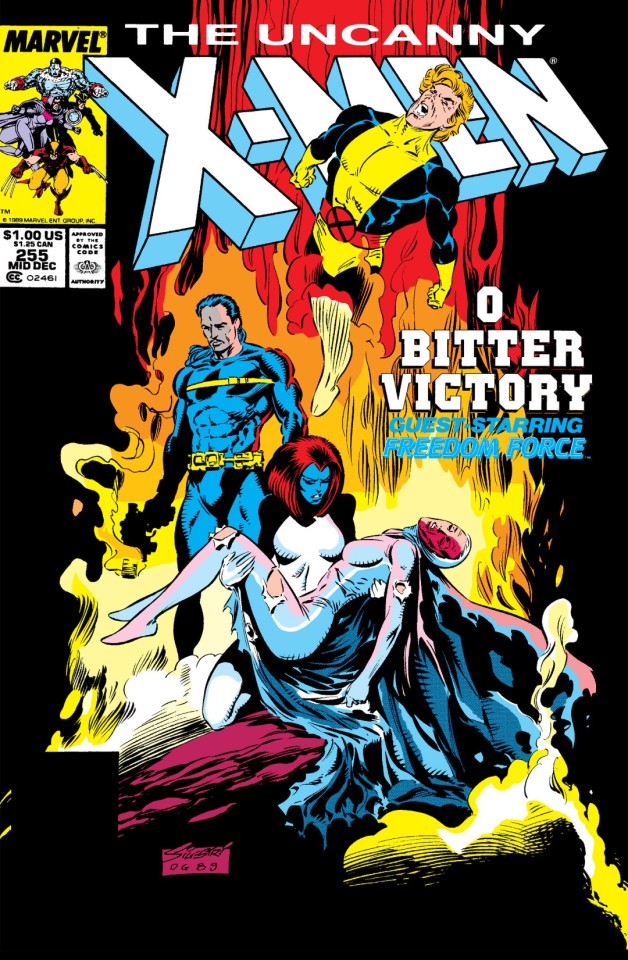
I can’t wait to read the X-Men comics that are coming up next. Because I didn’t know what in the FUCK was going on in these comics when I was a kid and I’m hoping they make more sense now.
Anyway, I’ll be the judge of all that, once I get there. (I may even indulge in the Infinity Gauntlet omnibus because, you know, there’s a couple X-Men involved in that). But regardless of what comes after this, I think it’s also true that the crossovers presented in this reading are generally regarded with less respect than Chris Claremont’s earlier work on the series, such as the Dark Phoenix Saga and Days of Future Past. This I don’t agree with. While the stories in this reading do range in quality, with Fall of the Mutants definitely being the weakest of the three big crossovers, and even though the Uncanny X-Men portion of Inferno isn’t even the central story of that crossover (the critical story elements take place in the far inferior issues of New Mutants and <ugh> X-Terminators written by Louise Simonson), Claremont’s writing is still much stronger, more layered, and more elegant than anything else that is presented in these collections. These crossovers may not be as timeless or original as the most famous X-Men stories, but the writing here is still really darn good and engaging (at least in Uncanny X-Men), and in my opinion, does not represent a decline in aptitude on the part of the writer. It’s clear that Claremont’s writing has continued to mature and become more nuanced, so much so that when you compare it to the first issues he wrote for the series, it seems like he’s a completely different writer.
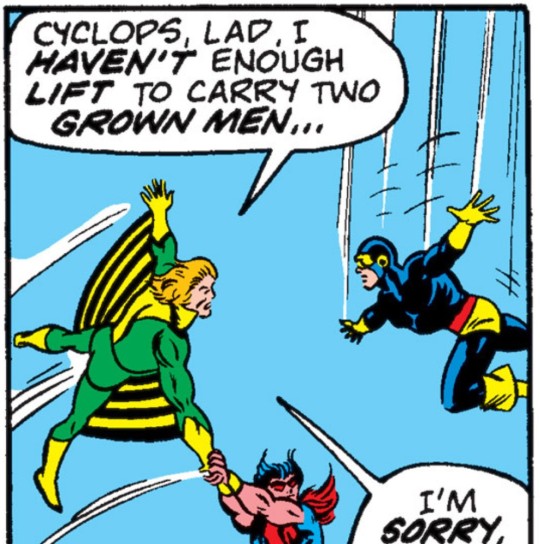

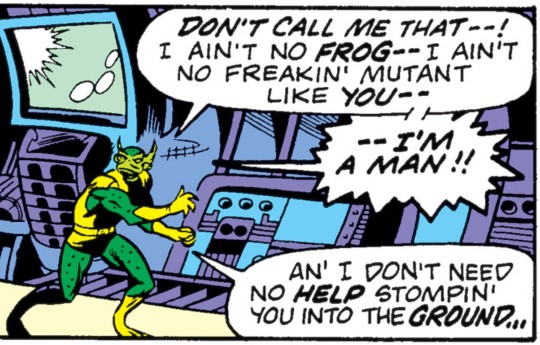
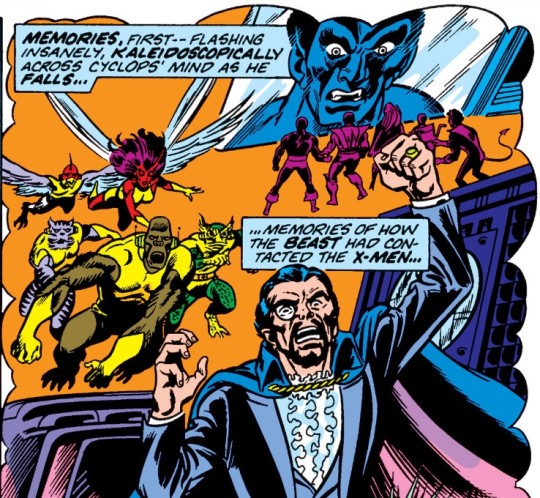
KALIDASCOPICALLY. Again, these were just the silliest panels I could find after looking for about 25 seconds.
Personally, I love this period of X-Men comics. Under Claremont’s executive control, no plot thread gets dropped. No minor detail goes disregarded. Characters continue to grow and develop at such a natural pace, sometimes it feels like my own life is developing right alongside theirs. This adds depth to these readings and I can’t describe how it feels to be a part of them, and I think it’s this element that is missing from so many other comic books written by so many other comic book writers, including nearly every X-Men story written after Chris Claremont left the series.
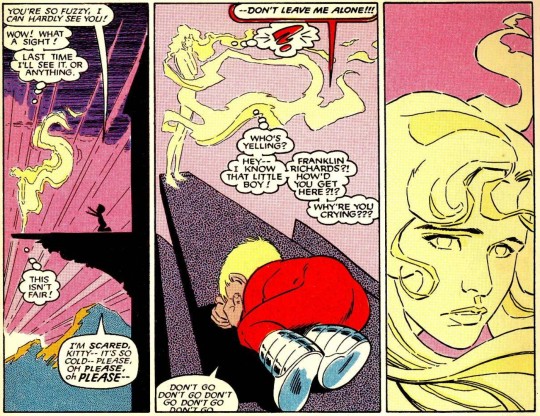
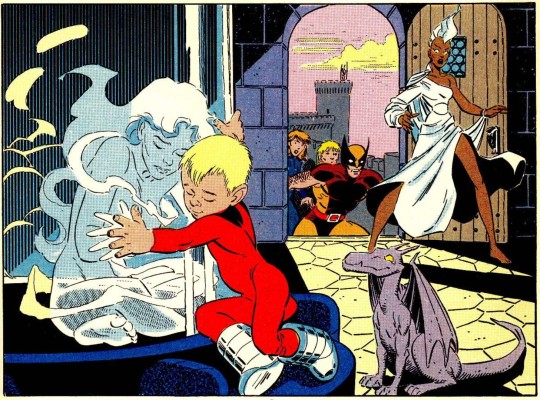
Case in point, there are so many minor recurring characters that appear in these stories, like Franklin Richards. (I seriously tear up every time I see these panels). This little guy bounces around the Power Pack, the X-Men, and the Fantastic Four like a ping pong ball. He’s a key character in the story line where Kitty Pryde finally recovers from the wounds she suffered during Mutant Massacre. And even though Kitty and Franklin have only met each other a few times, those meetings have meaning and they are remembered and called upon in the telling of the current story. All of the efforts made by the writers and editors to keep the narrative linked make these characters seem like real life people with weight and substance, rather than a thin layer of ink on a piece of paper. And it totally works.
Ugh, this review turned into another circle jerk about the writers of these comics, and especially about Chris Claremont. But what can I say. It’s because of the writers that we are here. Love or hate these comics, and I know Claremont’s wordy scripts are not everyone’s cup of tea, but these are the stories that make the X-Men what they are. It’s tough to be aware of these things when you’re in the middle of reading them, but I’m having the absolute best time writing this blog right now, and it is primarily because these are the comics that resonate with me the most. And when I’m finished with Claremont’s material and I’m slogging through some crap written by Chuck Austen, I bet I’m going to look back on these days with envy.
70 notes
·
View notes
Text
The Lutrudis Hadeer Characterization Masterpost
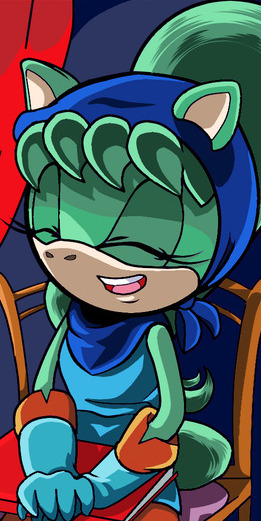
A while back, I made a big post about the thought process that went into the design for Lutrudis, as well as her name, species, and choice of weapons. In the midst of doing a bunch of other stuff (like the Eggman Sweet or Shite review, which is definitely still coming guys I swear, please don't leave me D':), I recently figured I could do the same for the character's... well, character, and provide some further insight into how her personality was shaped together. Cause why not, right?
Obviously, we won't be covering literally every single personality trait that Trudy has, like her hobbies and whatnot. If we went over all of that, we'd be so far into the future that Tumblr's search system might actually start working again. No, we'll just be keeping it to the central ingredients that make up the overall package.
1. A cool head? In my Sonic OC?
The recurring cast in the Sonic universe is filled with fiery, hot-blooded sorts in one way or another. Sonic might as well be the love child of Mentos and Diet Coke with how full of energy he is, Knuckles and Amy are both prone to letting their temper do the talking, Eggman... is Eggman, and the list goes on. And while there are a number of characters who are more low-key or even outright introverted by comparison, they still tend to exhibit a trait or two that makes them more in-line with the rest of the crowd, be it youthful excitement (Tails, Cream), a fiery temper (Blaze), or the odd bit of cockiness (Shadow).
So what better way to help make Trudy stand out... than by not really having anything like that at all? Contrary to most of the hot-blooded cast, it takes a lot to truly enrage her, and even then, you'll be lucky to get anything past tranquil fury. She's not particularly hammy either - flowery with her language at times, certainly, but not hammy - nor is she a cocky type, even against the weakest or most ridiculous of opponents, and although she does grow as a person over the course of the story she's involved in, all of this remains fairly consistent.
That's not to say that Trudy is not a passionate person. Far from it, in fact. She has a lot of passion. She just shows it in a different way than the average Sonic character.
2. Lutrudis? More like Unsureofdis.
Uncertain characters are also somewhat rare in Sonic's recurring cast (at least in the game universe), and just like with the previous point, even when they're there, they'll usually have something to counter it. Blaze may have been a bit insecure before meeting and befriending Sonic and Co, but as mentioned, she’s got a fierce temper, and even when she started off on her own, she felt that only she could take care of the threat of Eggman and Inferior Eggman Nega. Likewise, while Silver may have doubted himself about Leslie the Crack Dealer’s Iblis Trigger ruse cruise, he still got cocky when he had Sonic on the ropes, and he could be quite full of himself in the Rivals duology as well.
The point being, they still tend to show some semblance of the same “yep, I'm the one for the job, no questions asked” confidence and swagger that nearly everyone else has, no matter the flavor. Trudy, suffice to say, does not have this mentality. Trudy accepting Sonic and Co's help in dealing with sinister affairs in Viridonia without any haughty protest on her part isn't just because she knows they can handle it, or because they're Sonic Heroes and they'll show 'em the real superpower of teamwork... it's also because she's genuinely not sure if she would be able to take care of the matter on her own.
When she saved Cream from the wrath of the Wraith for example, she wasn't thinking “This looks like a job for Miss Hadeer!”
She was thinking “This could very well get me killed, but I have to help the poor bunny somehow...”
In other words, Trudy doesn't consider herself to be some sort of destined protector who has to do this herself. She constantly second guesses herself, and frequently believes her friends are more qualified and competent than she is. Her only reason for doing her best and helping out regardless is simply because she wants to.
3. A light at the end of the tunnel.
For the sake of tact, it's not shoved in your face relentlessly, but reading between the lines, it can be easy to get a sense of melancholy from Trudy. Particularly due to past experiences, she does indeed have an element of depression within her, and this can occasionally show in her body language and facial expressions, even if she's currently feeling positive emotions.

And yet, notice how she continues being a friendly pony. Notice how regardless of her experiences, and her thoughts on said experiences, her actual behaviour is (mostly) free of bitterness or cynicism, and that she doesn't hide the joy that her new friends make her feel. She's not outright ignoring her experiences or pretending they don’t affect her, because they clearly have affected her, and she's never ignored her scars (metaphorically and literally, the latter being a permanent side-effect of her condition), but she knows better than to let it consume her, so she tries her best to look at the bright side of life even during the darkest days.
It's Sonic's opinion that Trudy's inner spirit is a lot stronger than she thinks, with or without his help. Her refusal to give into misery and lash out at the world foreshadows that he's not unjustified in that belief. That, and it ties into the franchise’s usual taste for optimism and idealism against the odds.
4. Hadeer? More like Hadork.
So, everything thus far helps set Trudy up as a mellow, down-to-earth sort of personality. So far, so good. However, it's still the Sonic the Hedgehog universe we're talking about, filled with many colorful characters of all shapes, sizes, and eccentricities. When a franchise has a larger than life cast in a larger than life world, the characters who are meant to be grounded often risk coming off as boring and could end up easily overshadowed, because the creators or writers often neglect to give them any quirks of their own, usually out of fear that it'll disgrace the character's gracefulness. In fact, I personally feel this was a common problem with Sally, in both SatAM and Archie (mostly pre-reboot admittedly).
IMO, these writers are just being plain old silly. Just because a character is quirky doesn't mean they forfeit all their dignity altogether. Like a lot of things in life, you just have to balance it out, and that's what I did (or tried to do...) with the green equine.
So yes, Trudy is elegant, but she's also a really goofy dancer. Yes, she's gentle and motherly, but she also goes back and forth between being a heavy sleeper and being an insomniac. Yes, she serves as a warmhearted auntie figure for Cream (and a big sister figure for Amy), but she also spends a quarter of her time looking like a ninja with the way her bandana covers her face (whether it be due to cold weather, strong scents triggering her sensitive nose, or doing it in the presence of villains as a mildly theatrical way of visually conveying her disdain for them).
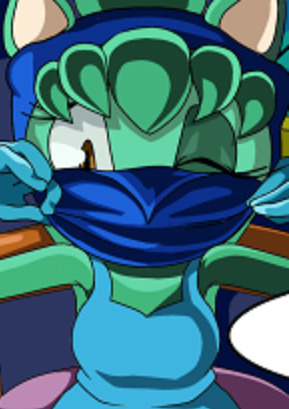
And of course, in the right situation, she can be just as much of a dork as the titular blue hedgehog is.
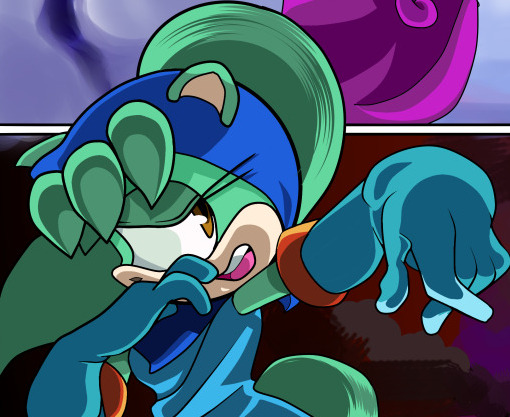
Which leads me to my next point...
5. “You might know everything I'm going to do...”
Trudy was created with the intention of having a character who is actually like Sonic himself in a lot of ways, but it's not apparent initially.
This sort of yin-yang contrasting routine has been done before a few times in the series, with Knuckles, Shadow and Blaze being the most obvious examples. But with them, their similarities are easier to spot from a distance. Knuckles is more earth than wind, but you can tell he's as stubborn as Sonic is. Shadow's methods and outlook differ, but you can tell he's still a mirror of Sonic (cause you know, he looks like him). Blaze is more distant, but you can tell how she can easily be just as worked up and angered as Sonic.
With Trudy however, if you take her at face value, you would think she's the exact opposite of Sonic. She's an introvert, he's an extrovert. She's got a calm temperament, he can get impatient even at the best of times. She's quite fancy, he's more rough and tumble. She takes things slowly, he leaps ahead without a care in the world... You would think that, outside of them both fighting for good, they would have nothing in common, and that their dynamic would be more akin to Sonic's relationship with Sally, which although they were friends, their relationship could often be somewhat rocky due to their differences in... basically every area and opinion imaginable.
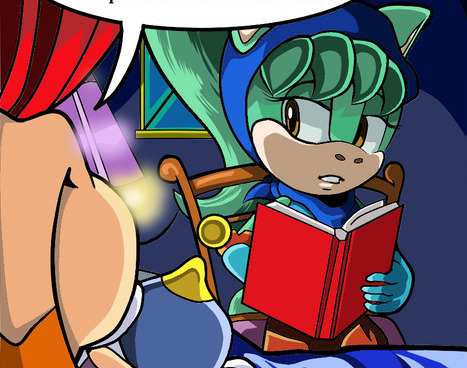
But then you get to know Trudy, and the unfolding of the adventure reveals the rest of what she has to offer. The aforementioned soldiering on in spite of any depressed moments is in itself a small hint that Trudy shares Sonic's philosophy of never giving up. She believes that most people are good at their core, and while she won't excuse especially evil people or actions and will punish them appropriately (albeit with regret that it had to come to that), she's willing to give a chance to those who are willing to take it, just like with the Blue Blur. Not only does she NOT find Sonic's jokes and hijinks annoying, she actually has a similar sense of humor herself. And while reasonable people generally tend to loathe injustice and oppression, Trudy shares Sonic's uniquely intense contempt for it, and believes in one's own personal freedom just as much as the hedgehog does, let alone freedom in general.
In short, Trudy is what you get when you take Sonic's deeper qualities and general outlook on life, and apply them to a more introverted and taciturn personality. The exact same beliefs, but from a different perspective, so to speak.
6. A different kind of intelligence.
Tails and Eggman are the resident kings of scientific prowess in Sonic's world, and it goes without saying that I wouldn't want to do them a disservice by having Trudy one-up them in that department. But that doesn't mean your character can’t be talented in other areas, right? Contrary to what all those Mary Sue tests dictate, your character can in fact have a high IQ without intruding on an official character’s territory.
Therefore, Trudy is pretty good at innovation and craftsmanship in her own right, but whereas Tails and Eggman do it through technology, her field of expertise is more to do with arts and crafts, and to a lesser extent geology. For example, both her bow and her whip were crafted by the lady herself, using nothing but her decorative knowledge and flair.
Outside of that, she tends to know a fair bit about a lot of things in the world, largely attributed to her photographic memory, meaning she's bound to have a few answers no matter the subject of discussion. Granted, she's unlikely to be the absolute number one expert on any of those things, but she's at least a useful jack of all trades in that regard.
7. Feeling a little horse.
I very much approve and flat out adore the idea of Sonic characters having characteristics that remind the audience of what species they're supposed to be, so I made sure that Trudy had a wide selection of little mannerisms that would reveal her for the little horsie that she is. These include, but aren't limited to...
- When she’s fascinated or concerned by something, she’ll lean a little forward with her hands close to her chest, which subtly mimics the act of prancing.
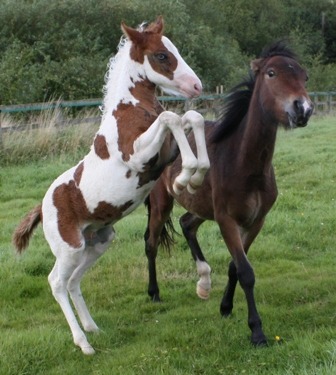
- When she wakes up, she briefly stretches her arms and legs (albeit not too recklessly so as to risk straining her sensitive limbs).
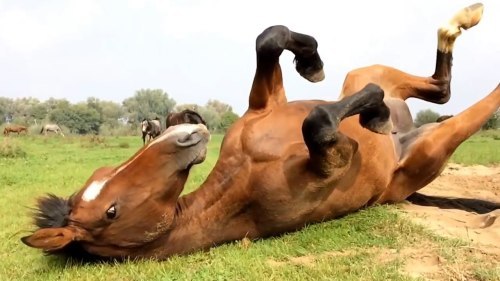
- Her tail has a number of quirks. If she's happy, it might slowly swish to and fro. If she's REALLY happy, it might flick...
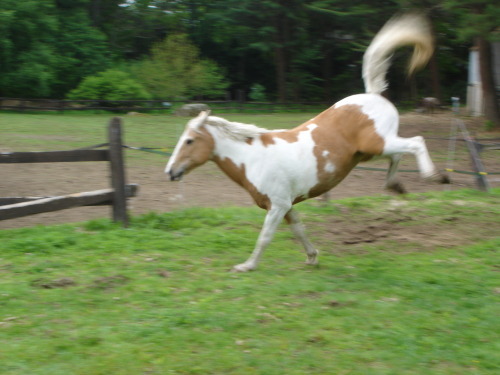
- And if she doesn't approve of someone or something, it might stiffen and raise a little bit, as if to helpfully inform the bad guys where they can kiss, if ya know what I'm saying.

- When she's being affectionate with her friends, she might give them the ol' nuzzle.

- When she's in a playful mood, there might be a little skip in her walk, the anthro equivalent of trotting.
- When she's annoyed, she might humorously let out a snort that sounds identical to a real life horse snort. And while she certainly doesn't neigh in the traditional sense, when she finds something hilarious or Sonic's making her laugh with his antics, her laughter can't help but take on a neigh-like touch to it. (The latter was actually a headcanon suggested by @darklightheart, and I immediately agreed with it because it's cute and funny in equal measures.)
Naturally, she gets all shy and embarrassed when the neigh-laugh comes out, thinking it sounds silly. At least Sonic finds it endearing.
Note that I'm well aware that some of this differs from how real life horses react to certain things. (Eg: tail swishing tends to happen when a horse is agitated rather than happy.) But I freely admit that it's more for the sake of giving the character that extra bit of soul than it is for utmost accuracy. That's the way it goes with fiction sometimes. :P
Interestingly, Trudy tends to get Sonic indulging in a funny hedgehog characteristic of his own. That being, he might curl into a ball if Trudy's being particularly... ~complimentary~ towards him.
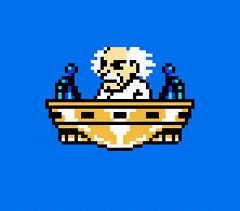
And there we are! These are the core elements that make up Trudy’s characterization. If you ever wanted a general list of what makes her tick, then hopefully this post will help in scratching that itch. And if it doesn’t, then hopefully it still proves that more thought was put into her than Scourge. :]
30 notes
·
View notes
Text
Advent of Code
As a child, advent calendars always added to the sense of anticipation in the lead up to Christmas. In my day you would be lucky to get a small picture behind each of the doors. These days, children expect chocolates or sweets. My wife has once even had a "Ginvent Calendar", with gin behind each door.
This year I marked Advent by having a go at the "Advent of Code" which has Christmas-themed programming puzzles posted each day. Most days are in two parts, with an easier puzzle followed by a harder one. Traditionally, I've posted a (mostly ignored) programming puzzle to our development team each Christmas. Last year I just recycled one of the Advent of Code puzzles, but this year I suggested we attempt the whole thing. The puzzles are so well thought out, in comparison to my efforts, that it seemed pointless to compete.
In the end, several of the team had a go. Some of the puzzles were harder than others, but I managed to solve them all by Boxing Day. What follows are some personal anecdotes from the various days with some general thoughts at the end. Note that there are some spoilers and the notes won't mean much if you've not done the puzzles. So in this case just skip to the end.
a sum-finder. I implemented the search tree via recursive calls. I drifted into using Python right from the start. It just felt like the easiest way to hack the puzzles quickly. In the past I had thought about using the puzzles to learn a new language. A colleague had done that with Rust in a previous year. Despite these good intentions, expediency took a firm hold. That said, in several puzzles I would have liked immutable collections or at least Lisp-style lists.
a pattern counter. Not that interesting except patterns were emerging in the programs themselves. Regular expressions got used a lot to read in the puzzle data. I learnt about things like match.group(1,2,3) which returns a tuple of the first three match groups, so you don't have to write (m.group(1), m.group(2), m.group(3)).
a grid tracer. The first interesting one because it was unfamiliar. Some other patterns started emerging: problem parameters got promoted to command line arguments, and data structure printers got hacked to help debugging. These two were often added between part 1 and part 2 of each problem.
a data validator. This felt like a bit of a slog. It was mostly about capturing the validation rules as code. Even though I made a point of reminding myself at the start that re.search doesn't match the whole string I still forgot it later. Duh.
an indexing problem. I patted myself on the back for realizing that the index was a binary number (or pair of binary numbers as I did it). At this point the solutions were still neat and I would do a little code golfing after the solution to tidy them up a bit and make them more concise.
another pattern counter. Pre-calculating some things during data reading kept the later code simple.
a recursive calculator. This was one of those puzzles where I had to reread the description several times to try and understand what it was asking for. It entailed a slightly tricky recursive sum and product, which was again made easier by creating more supporting data structures while reading the input data.
an interpreter. Probably my favourite individual puzzle because it was so sweet, especially after a bit of refactoring to make the language more data-driven.
another sum-finder. I found I didn't particularly like these.
an order-finder. This was the first one that made me pause for thought. An overly naive search algorithm from part 1 hit a computational complexity wall in part 2. I beat the problem by realizing that the search only had to be done on small islands of the data, but a colleague pointed out there was a better linear solution. The code was starting to get a bit ragged, with commented out debugging statements.
the game of life. The classic simulation but with some out-of-bounds spaces and some line-of-sight rules. It helped to print the board.
a map navigator. I liked this one even though I forgot to convert degrees to radians and that rotation matrices go anti-clockwise. I even introduced an abstract data type (ADT) to see if it would simplify the code (I'm not sure it ever did - I mostly used lists, tuples, strings, and numbers). The second parts of the puzzles were starting to get their own files now (usually bootstrapped by copying and pasting the first part's file).
a prime number theorem. I actually got stalled on this one for a bit. It eventually turned out I had a bug in the code and was missing a modulus. In effect I wasn't accounting for small primes far to the right. I left the puzzle and went on to complete a couple of others before coming back to this one. I checked what I was doing by Googling for hints, but in the end I had to take a long hard look at the data and find my own bug.
some bit twiddling. Part 1 felt like I found the expected bitwise operations, but part 2 felt like I was bashing square pegs into round holes.
a number sequence problem. Another pat on the back, this time for keeping a dictionary of recent occurrences and not searching back down the list of numbers each time. Another recurring pattern is evident: running a sequence of steps over the data. I liked to code the step as its own function.
a constraint solver. A nice one about labelling fields that satisfy the known constraints. Half the code was parsing the textual rules into data.
another game of life simulation. This time it was in more dimensions. I generalized from 3 dimensions to N instead of just doing 4. This made it more of a drag. I started naming auxiliary functions with placeholder names (social services should have been called). Also, I tacked on extra space along each dimension to make room at each step. This felt very ugly. I should have used a sparser representation like I did for day 24.
an expression evaluator. I used another actual ADT and wrote a simple but horrible tokenizer. The evaluator was okay but I hacked the precedence by inserting parentheses into the token stream. Don't try this at home kids.
another pattern matcher. Probably my biggest hack. My code compiled the pattern rules into a single regular expression. This was cute but meant the recursive rules in part 2 needed special treatment. One rule just compiled into a repeated pattern with +. Unfortunately, the other rule entailed matching balanced sub-patterns, which every schoolchild knows regular languages can't do. Perhaps some recursive pattern extensions might have worked, but I assumed there would be no more than 10 elements of the sub-patterns and compiled the rule into a large alternative of the possible symmetrical matchers. Yuck.
a map assembler. I did this one the most methodically. It had proper comments and unit tests. Overall it took the most code but perhaps it was just dealing with all the edge cases (ba dum tss). But seriously, it seemed to take a lot of code for rotating and flipping the tiles even after knowing how they must be connected. So probably there was a better approach. It was still satisfying the see the answer come out after all that work. Curiously, this one involved little debugging. I wonder if perhaps there is some connection between preparation and outcome?
a constraint solver. I tried a dumb approach first based on searching all the possible bindings. That didn't look like it was terminating any time soon. So I reverted to a previously successful technique of intersecting the associations and then then refining them based on the already unique ones.
a recursive card game. This card game playing puzzle seemed to be going okay, but the real data didn't converge for part 2. Had a quick Google for a hint after battling with it for a while, and the first hit was from someone who said they'd misread the question. Sure enough I had too. My recursive games were on the whole deck instead of the part dictated by the cards played. Duh. The description was clear enough and included a whole worked game. I just hadn't read it properly. It still seemed to need some game state memoization to run tolerably fast.
a circular sequence. Took three attempts. A brute force approach using an array was good enough for part 1, but no way was it going to work on part 2. Even optimizing it to use ranges was still 'non-terminating' for the array-based solution. So I Googled for a little inspiration and found the phrase "linked lists" and slapped my forehead hard. I switched to a dictionary of labels to labels and the solution popped out very easily, without any further optimization. Embarrassing. Was it time to ceremonially hand in my Lisp symbol and fall on a sharpened parenthesis?
another game of life. This one sounded neat because it was about a hex grid, but I didn't know how hex grids are usually indexed. So for the first time I did a little bit of general research at the start. Turns out there are a bunch of ways to index a hex grid. I opted for using 3-axes as that seemed natural despite the redundancy. The map itself was just a dictionary of locations. I should have looked up how to have structured dictionary keys in Python (implement __hash__) but I couldn't be bothered so I (look away now) serialized and deserialized the locations to and from strings. I still had a bug which I couldn't find until I hacked a crude hex board printer and realized I wasn't carrying the unchanged cells over from one iteration to the next.
a cryptographic puzzle. Came out quite short but only after some faffing around. Main trick seemed to be to keep the transformation ticking along instead of recalculating it from scratch each time. There was slight disappointment (tinged with relief) that there was no part 2.
Some general lessons I felt I (re)learned:
Read the questions very carefully, then reread them.
Try and use terms from the questions. Don't invent your own terminology and then have to map back and forth.
Make the trace output exactly like the examples to help comparison.
Next time I'd consider using BDD to turn their examples directly into tests. Next time.
Try the problem for a while by yourself, then think about it offline, and only then Google for hints.
Next time I'd consider using some form of source control from the start, or just a better set of file naming conventions.
Regular expressions go a long way, but can then they can get in the way.
Next time I'll consider doing it using a language I'm learning.
Sometimes when you get stuck you have to start again.
During some low moments it all felt like make-work that I'd inflicted on myself, but in the end it was a nice set of training exercises. I'd encourage others to have a go at their leisure.
"Practice is the best of all instructors." -- Publilius Syrus
2 notes
·
View notes
Text
A WNBA Wishlist for NBA 2K21 & Beyond

The current state of the world has created newfound time for many of us while we wait for sports to resume and, much more importantly, life to return to some semblance of normal.
To pass the time, and to follow the recent buzz created by the 2020 WNBA Draft, I have taken a deep dive into NBA 2K20’s WNBA integration and created a wishlist of features for the next iterations of the game. The first year of WNBA in 2K surpassed EA Sports’ two-year head start with NBA Live 18 and Live 19 on a number of fronts; that said, for 2K to bring the integration up to the standard W fans deserve and their industry-leading NBA simulation has created, I’ve logged these 20 things need to be added as soon as possible:
Fix the In-Game Commentary Audio
One of the most glaring issues for 2K20 with the WNBA were the multiple instances of the in-game announcers misgendering player actions (using “he/him/his” instead of “she/her/hers”). I haven’t heard any actions in NBA modes using female wording so hearing it in the W games makes the mode feel a bit unprofessional. There are some times where these mentions could just be unclear pronunciations, but even that happening in a game where there is usually so much polish on the commentary is a problem. I’ve had fellow gamers on Twitter confirm that this has happened to them so it’s definitely not an isolated incident.
Choose more recognizable and more diverse announcers
The all-male trio of announcers in the WNBA modes did an admirable job providing commentary in the games. While I generally enjoyed their commentary (sans point No.1) and it seemed to get better after launch, sometimes their insights into players were a bit formulaic (a descriptor, player name, another descriptor). Initially, hearing these anecdotes about the players was refreshing but noticing this recurring template was disheartening after a while. Also, in a game that has a wide mix of recognizable, veteran NBA announcers on the men’s side and sports the great Doris Burke among that mix, it was hard to understand how the WNBA mode only possessed an all-male crew unknown in WNBA circles.
A list of seasoned WNBA/women’s basketball announcers that should be approached for 2K21 and beyond include but are not limited to: LaChina Robinson, Kara Lawson, Rebecca Lobo, Adam Amin, Ryan Ruocco, Christy Winters-Scott, Carolyn Peck, Doris Burke, Holly Rowe (who could also serve in David Aldrige’s sideline role), Cheryl Miller, Debbie Antonelli, Pam Ward, Rosalyn Gold-Onwude, Maria Taylor, and Ann Meyers.
Add the pre-game/post-game shows
If any of the veteran announcers could be added to 2K21, it would make perfect sense to create a pre-game/post-game panel package for the W. Any grouping of those announcers could easily create analysis for the teams and give the women the same treatment that Shaq, Kenny Smith, and Ernie Johnson give the men.
Extend the season mode past one season
Being able to play a full season in 2K20 was one of the game’s best features. However, knowing that you couldn’t go into multiple years like in NBA MyLeague was disappointing. Knowing this, I still grinded through a season with the Las Vegas Aces from launch until a few weeks ago (for the record: 27-7, Liz Cambage as MVP and Finals MVP, and a title!) only to be left with the empty feeling of not being able to have my curated team (with a few late season trades) run it back in future years. Maybe the full 80-year NBA MyLeague treatment can’t be done, but having the auto draft classes, progressions, and offseason items necessary for a 15-25 year run should be doable.
Allow for creation of female players, custom rosters and draft classes
As more and more attention is given to women’s basketball in this social media age, devoted fans may want to create draft classes of future college stars like NBA fans already do. Adding the option to create female players - individually or en masse - is necessary to allow for longer engagement with the league in the game. Outside of visualizing future players, being able to save and load custom rosters is also needed. This year’s one-season MyLeague would have been more bearable if I didn’t have to manually alter any fantasy rosters I wanted to experiment with every time I started a season.
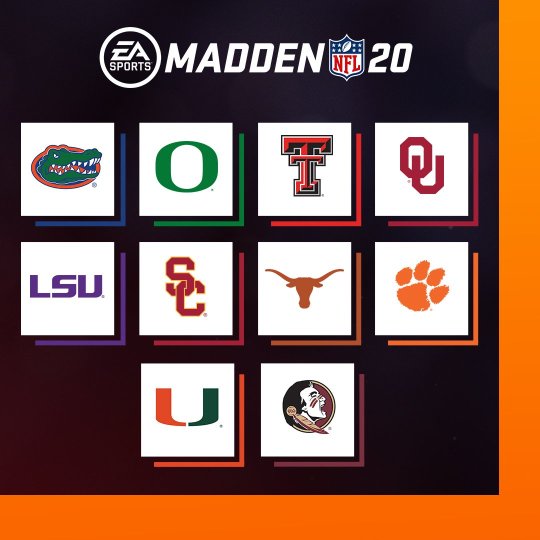
Add a MyCareer storyline/path for Female MyPlayers to make the league
In past editions of 2K and past versions of the Madden NFL franchise, game creators have worked around the NCAA’s old name, image and likeness restrictions by getting basic licenses from colleges to use their logos with generic rosters in MyCareer-type modes. Madden NFL 20’s Face of the Franchise mode particularly stood out: your QB chose a college to go to, and then as a senior played against two schools in the College Football Playoff semis and final.
A similar setup could be created for a Female MyCareer story: get a team license for 4-8 of the top women’s college basketball teams and have the created player go through the latter stages of the NCAA tourney before getting drafted to the W. Someone could create a player, choose from the licensed schools to commit, play a handful of games versus the other licensed schools (and their auto-generated rosters) in big moments over four years, and end by going through top teams as a senior (either with or without graduated alums in the W; imagine having to face Sabrina Ionescu, Satou Sabally, Ruthy Hebard and Oregon or Tyasha Harris, Mikiah Herbert Harrigan, Dawn Staley and South Carolina for the title to set your draft stock). Simulate the draft with Commissioner Cathy Engelbert like it’s done with NBA Commissioner Adam Silver, and roll right into your season with the same bells and whistles as a male MyPlayer.
Allow Female MyPlayer into the Neighborhood/Park areas
I personally don’t play too much of the online Park games in 2K (another story for another day) but just like on basketball courts around the world, if female MyPlayers are available, they should be able to run with the guys. The Neighborhood could be broken up three ways: a portion for guys only runs, a section for girls only runs, and a co-ed section. Give the female MyPlayers the same access to all the perks of the Neighborhood (gear, the Gatorade training center, MyCourt, etc).
Allow for Playoff Only Mode
The WNBA Playoffs are probably the most unique in all of the major sports leagues. Adding a Playoff only mode to the season mode would allow for more content to be created and simulations to be run, especially if All-Time and Classic teams are added.

Continue to improve on strong face scan data
2K’s face scans were great out the gate in both quality and quantity. Continuing to improve on that start to gain 100 percent accuracy has to be the goal. Scanning sessions will probably be difficult in the current age of coronavirus, but if fans can scan their faces in the game with an app, I’m sure something can be done with the W’s players remotely.
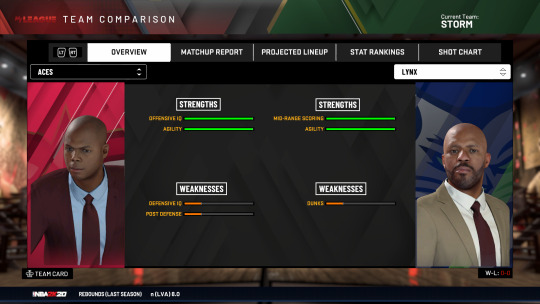
Scan in and/or properly gender each head coach
We heard that some WNBA coaches - if not all - were scanned for 2K20 but none of them are in the game. If correcting this can’t be done in 2K21, at least put in generic stand ins of the correct gender and race. Example: Minnesota (Cheryl Reeve - white woman) and Las Vegas (Bill Laimbeer - white man) both have black male avatars as their head coaches in the game. All 12 coach avatars in the game are men and even though there are more male coaches than female ones in the league, the virtual stand-ins are still incorrect. If the game could get unique scans for cheerleaders and female characters in MyCareer, I’m sure some stand in men and women could be added if the WNBA coaches can’t be added like their NBA counterparts.
Align commentator and arena PA announcer pronunciations
A subtle tweak: making sure the game announcers and the in-arena PAs are announcing players’ names correctly. I’ve heard some very off names on both sides
Halftime: show team stats screen for longer than four seconds
When I’m in a game and want to look at the halftime stats to figure out how I’m doing, I’ve felt rushed because the team stats graphic that shows in-between halves comes down just as quickly as it goes up.
Allow for online Play Now
The NBA and 2K found a way to entertain its fans during our quarantine with online competitions that were aired on TV. If the WNBA season is postponed or cancelled, the league cannot facilitate a similar tournament in 2K20 because the only way for two people to faceoff with W teams is in the offline Play Now mode. Bringing in an online option will expand opportunities for fans to learn about the WNBA players and teams.
The defending champion Washington Mystics recently decided to do streams of their games on 2K but only as CPU vs CPU simulations instead of remote player vs player. Not having the ability to play someone else online limited their options and engagement opportunities.
WNBA Finals: actually put in a celebration sequence
As I (proudly) mentioned, I won the title in my LVA season and after the final game, there was a quick CHAMPIONS graphic...and that’s it. No trophy celebrations, no locker room celebrations, nothing. In my semifinals win to get to the Finals, the NBA “conference trophy” cutscenes played postgame at least. Adding that touch would surely be appreciated by the W community.

Double check player cutouts
Jordin Canada (SEA) won an award in my LVA season and her player image was Jewell Loyd. It’s the only error I’ve personally seen on the player cutouts but checking those are important.
All-Time Teams and Past Champions
Adding Classic WNBA teams and/or legends via All-Time teams would be the ultimate way to honor the league’s history and give old and new fans that pick up 2K a virtual time capsule of the W. My suggestions would be to add:
Champions and Runners-Up from every year (1997-present)
All-Time Teams that go 10-12 deep (I took a crack at suggestions here): https://bit.ly/2xFW2HL. I’m sure some W writers with deeper knowledge than mine could fill in the blanks.
Add a 2K League connection/element
Tying back into the online Play Now mode, incorporating the NBA 2K League with WNBA action would be amazing. Either have the 2KL teams do special tourneys using W teams; create events or a full league for the W that has to be at minimum 75% women (because, shoot, I’d want to play too!); or do WNBA player-specific events. Imagine how cool it would be to see Aerial Powers and Allisha Gray going at it as themselves in 2K instead of just picking NBA teams.
Put in some general trade logic
Currently, any trades in the MyLeague mode are set to automatically go through, no matter how outrageous. Some basic trade logic (at minimum based on overalls, salary and position) would be nice to give things a realistic feel.

Fix the jerseys screen in season
In WNBA Play Now, when you go to adjust jerseys, there’s a graphic with WNBA players in the background. In Season, that graphic is of NBA players.
Honor Gigi Bryant, Payton Chester, and Alyssa Altobelli, and Kobe Bryant
Follow Commissioner Engelbert’s lead and find a way to honor Gigi and her Mamba Academy teammates. Maybe permission can be granted to create older versions of the girls to be placed into the game’s free agent pool.
At minimum, having some kind of graphic commemoration would be classy (maybe banners throughout the game or at Staples for Sparks games, since they were California natives). There’s also been the obvious rumblings of putting Kobe and Gigi on the cover. That would be amazing. If that can’t be done, a cover with Kobe and a WNBA player he was close to (Ionescu, Diana Taurasi, Loyd) would be fitting.
I do not want this list to diminish what 2K has excelled at with its first run with the WNBA. The gameplay is fun and true to form, the graphics are high quality, a very large amount of the face scans are on point, being able to play a full season is an excellent touch, and the features that are in the game are strong. However, 2K as a whole has a decades-long reputation for putting out a pace-setting game every year so wanting the WNBA’s section of it to be fully developed is something every true basketball fan can agree on.
I can’t wait to see which of these suggestions or others are implemented. What features would you want added for the WNBA?
1 note
·
View note
Text
Red Dead Redemption 2 PC
Red Dead Redemption2 PC
The old west feels brand new again.
Oh Jesus Christ, what have you done? “Thomaschen 978 wants to know why a dozen carcasses and a couple of horse corpses are placed on rail tracks bordering the early industrial city and are the New Orleans stand-in St. Denis.” You killed half. village.” PC Games For Free
We are on round two of the recurring corpse pile. My poses got the idea to jump in front of the train after a few rounds of Lose Your Friends and Toss Them in the Sea in the Couple Friendly Strangers. Like GTA 5, Red Dead Redemption 2 has its own bowling minima, we explain to Chen in a roundabout way that provokes his fear. Die in the shared open world of Red Dead Redemption 2 and you’ll react fast enough to move your corpse around. Best RPGs games pc
The boy is in line with us. We should make it bigger. As the train comes around again, another pose tries to take us out. The chain defends us but does not bring it back to the tracks. He goes away screaming. Death of a true warrior.
Red Dead Redemption 2 could be the biggest, most humble videogame ball pit for an annoying story about impulsive children, the forced disintegration of the community, or simply a quiet and reflective hiking simulator. It’s just about what you need it to be, and it’s good at it.
Just hours before the corpse-bowling, I was alone through the icy forests, stepping into the long shadow cast across the snow by the rising moon. I heard a gunshot from a distance. The tracks of some wolves marked snow in the same direction. I saw them who won. Anytime I pay attention and look closely, RDR2 is the result of my curiosity. Best Racing games on pc
The mind-numbing expanse that makes up the vast world of RDR2 speaks to the creative force of a development team with an intense, obsessive dedication to realism (and all the money and time needed to do so). Like how my friends’ characters flare up when I fire a gun at them, how animal carcasses disintegrate over time, how NPCs react according to a sloppy or bloody outfit, how to stir through a doorway. Scares everyone everywhere.
It is hard to believe that RDR2 is so deep and wide and is also a harmonious, playable thing. I was already playing it for days worth the console version. This is why I am particularly disappointed that it ended up on the PC to some extent.
For every non-taught multiplayer adventure, disconnect or crash on the desktop, desktop. The rock star’s best storyline and character so far has been filmed through Frame Hutches’ slideshow and addressed over the launch weekend.
RDR2, one of the best Western games and one of the best open-world games I have ever released with enough stability issues, is recommended for the hard way until everything is completely smooth.
Morgan trail
EVERY PRETTY VISTA IS SOMETHING TO LOSE THROUGH ARTHUR’S EYES.
The story genre of Red Dead Redemption 2 follows the dying days of the Wild West. The sprawling industrial world faced the bandits and social downtrodden of Arthur Morgan’s small band, an imperfect but loyal, loving and self-reliant community.
Capitalism is reducing its value as resources to humans. Indigenous USA America is driven from the plains to make way for ‘civilization’ and commerce. The forests are brought down for timber, the hills are cut down for coal, and Morgan’s chosen family is caught in the middle, forced to flee, assimilate, or respond with violent protests is done. They do all three.
This is Rockstar’s most serious drama, and it’s really, really long. If you are running, the story ends after 40 to 50 hours and then continues for 10 to 15. The main story missions of Red Dead 2 feature distinctly rockstar fare: ride to a destination that is talking to everyone, tightly scripting though, entertaining things, riding, and chatting to the final destination.
Missions are often thrilling action sequences or artificially mundane pictures of wrench labor and trade, full of long-winded Bespoke animations, and outstanding performances. They are only hopelessly harsh, to the point where it feels like I am following the stage directions rather than playing the role of a vagabond in the Old West.
Step out of line in these campaigns and this is a failed situation. As opposed to Red Dead Online, there are very few of them that encourage players to think for themselves, each designed to advance the story. The RDR2 show is at least a spectacle of the slow pace of life in the Old West.
This is not the death and theatricality of a lifetime; My favorite missions include shoveling, drinking wine with a friend, proposing an old romance and riding a hot air balloon. Working through a greater rut, stricter tasks are considered meaningful in the end anyway, inspired by extraordinary, ambient world-building and characterization.
Side missions, minigames, small activities, and random world events — whether they hunt great guns, capture a play, or stumble upon a woman trapped under a horse — all set Arthur’s character and setting in subtle, rich ways. Please inform.
Nested in the third act of a fully animated and voice theatrical performance, something like 10 minutes, it is possible that the response button is pressed after an artist has included a telephone. Arthur would shout, “Hell with the telephone!” It is an optional activity, a long one, and an option is to react in that short window. I think most players will remember this, but this is Canad Response 1 through 3 because this is something Arthur would say, a rageless goofy set his way in the right way.
He would write complete, real diary entries about the 50-hour campaign, sketching memorable scenes and depicting the state of affairs of his chosen family, which people once knew changed their fortunes between hope and despair. It is meant to be a completely alternative reading, but a refreshingly intimate take on a masculine figure that unsettles many doubts and hopes as to the next person.
He sings himself on a lonely ride and lowers his old body in the mirror. He will have an exciting conversation with the horseshoe woman as he gives her a ride into town, both commenting on the troubles of working for wealthy, ungrateful men as a growing necessity. I feel it all. Best horror games on pc free
Hillbillies can capture him after making the camp, a couple may try to rob him after inviting him to dinner, a man with snakebite can come out of the forest by stumbling and tell him to suck venom is. These haphazard encounters portray brutal life on the fading frontier, as nature pushes back against inner poppers who want to change it. Arthur is the perfect vessel to see it
This is because Arthur Morgan is one of the darkest human characters I have played during a great turning point in American history, playing a playful, cruel and compassionate role according to differing theories.
The game world, beautiful as it is, is made more beautiful and tragic by how it is ready to play it on every occasion. Every beautiful vista has something to lose through Arthur’s eyes, power lines and train tracks, cut through the skies, and the rest of his life is slowly filling with factory smoke. Just about everyone sees a sad end in RDR2, too. This is a story that I might not sustain every moment, but I will not forget its brutal arc or the man in the middle of it all. God damn is it sad? An apocalypse that led to this.
Ren Der Reflection
Assuming that you are able to run it at high settings, the biggest strength of RDR2 is how it exquisitely renders the Old West setting on PC, drawing more attention to the nuanced details that make it. This is one of the best looking games I’ve seen and a rare experience that justifies a new GPU or CPU.
Better draw distance and a greater range of vegetation detail were added, making some vistas look photographic. Long shadows vary from walking or roaming between places to rides, to cute nature tours. Due to animal attacks, bullet holes, rain, mud, or rapid flow of blood, the markings on the clothes are caused by very high-resolution textures, which tell a very little story about your friends.
A new photo mode makes it easy to share those moments of amazement. The way the player rides on RDR2 for just sightseeing and sounds is an important feature. I am desperately trying to get an artistic portrait of my horse’s silhouette to sit against the moon, yet another self-proclaimed goal was tolerated by this ridiculously large complex game.
With 2080, i9-9900K and 32GB of RAM, I can run RDR2 mostly on ultra settings with some resource-intensive settings completely off or switched off. But some hardware combinations are proving troublesome for RDR2, leading to random crashes in some APIs and, more recently, to a hotfix, leading to hitching problems for some 4-core CPUs.
During the first weekend, I couldn’t spend more than an hour without crashing on the desktop, though Vulcan switched from DX12 (which gives me better framerates) back to static stuff. Sometimes the UI malfunctions and I cannot select a select or purchase option, the map fails to appear, or I get paged unexpectedly from game servers.
The graphics settings are almost too much as well, and probably confusing. In our test, only a handful of settings affected performance by more than 1-2 percent. Large residuals, the mapping between MSAA, volumetric lighting, and parallax occlusion, affect performance by 5 to 25 percent. Most of them don’t make a big visual difference anyway and are best left out.
The way the settings are presented is made to feel underdeveloped: a huge list with unclear presets that require tinkering to make RDR2 run in a satisfactory framerate. It is hard. The PC should be the best place to play, not the best place to play, after all, after a few patches. It’s a shame for a game to look good. upcoming pc games
Cowboy poetry Red Dead Redemption 2 PC
Like in singleplayer mode, in Red Dead Online I can make my goals reasonable and watch them. The problem is, it is basically hamstrung by a frustrating multiplayer leveling system that locks basic equipment and cosmetics behind long XP requirements that can meet hours, perhaps days,
The option is spending gold, premium currency, items and clothing to unlock them immediately. A fishing pole is not available until level 14. A damn fishing pole in an outdoor recreation game. This is not spectacular and is a terrible way to invest players.
out a basic suite of tools (fishing rod, bow, varmint rifle, nice hat, etc.), Red Dead Online opened up widely. I have largely ignored traditional matchmaking modes such as gunfights and horse races, cheap thrills, I will play much better versions in different games, to have fun. It led to the most inventive, serene, real, and sometimes buzzing echo I’ve ever had.
I once walked into the middle of a fire in Blackwater and took the player corpses one by one to the church cemetery. Some were captured and participated in the ‘burial’ of their friends. A corpse thanked me for the gesture. Later, in an extended streak of criminal activity, my pose and I caught another player and instead of killing them on the spot, we rode into the swamp and threw them into the garter infected waters. I got the idea to act like a friend. Best pc games 2017
On a less absurd note, I set myself a constant goal of earning strictly enough money from hunting to buy cool-weather gear and a fine rifle. I am going to hike in the mountains and find the best way to hide there, a wild mountain man adorned with animal skins, which almost touches the floor.
In the meantime, I’m stopping gunmen across the city by running through the streets and calling for a parley. I am participating in an eight-player ballroom. I am living the life of a normal cowboy in the best shepherd game. I hope it clears up soon.
RDR2 PC System Requirements
OS : Windows 7 SP1 64bit
Graphics Nvidia GeForce GTX 770 2GB / AMD Radeon R9 280
Processor: Intel Core i5-2500K / AMD FX-6300
Memory: 8 GB RAM
DirectX: Version 11 Or 12 Support
Storage: 150 GB
3 notes
·
View notes
Text
My utopia is literally a place where I don't have to feel overwhelmed and overpowered when trying to express myself professionally or emotionally, because of overbearing aggressive forces of masculine energy. I want to feel at peace when I am outside, and I don't want to feel threatened or violated. I don't want to feel like it's my responsibility to educate men to be better, because it's emotionally exhausting and I always find myself doing that when I'm hurt.
Okay, so the space I would imagine is the wild from Madagascar where alex goes like who's the cat Im the cat. And there would be no gender like no dicks or vaginas, And anyone could fall asleep anywhere without any fear, And it would be summer all the time And everyone minds their own business and are introverts somewhat Also the houses should be made of clear glass
Earth’s balance has been restored.
We accommodate/conform to nature rather than dominate it.
• Live music is played in every restaurant
• Artistic expression is seen as essential to childhood development • Education is provided to all who seek it wherein history is taught from multiple perspectives, science is taught as tried and true, and language is taught as adaptable and ever-changing
• Homelessness eradicated.
• Plenty of public spaces where children can run around freely and people can gather without fear & without having to buy something • Dressing colorfully isn’t deemed unprofessional • We can communicate with animals which allows us to respect their space and autonomy
4. I guess my version of a utopia would look kind of like a combination of nature and modernist architecture (visually). Like a bunch of glass and wood buildings with trees. And some luscious as fuck gardens. I don’t know I was watching this thing on Japanese homes so I’m kinda obsessed with that right now.As far as the values of the society, I envision a utopia where education of all kinds is accessible to all people. And, it’s mad cheesy, I see it as a society where acceptance and respect have more value than wealth. Where all people are considered equal, yet everyone is able to laugh at their differences without hate behind it. I imagine there would only be public forms of transportation, excluding bikes and the like. Or we would have at least developed some super modern version of a car that doesn’t run on fuel. I don’t really know if I am doing this right? But I would just want it to look real sexy with lots of glass, modernist architecture and nature. As well as a high focus on providing equal opportunity for all people. Where money doesn’t get you the education that all people deserve.
5. My utopia is a beautiful jungle with all my best friends, mother, khalas and my sisters. We are able to talk to animals, and for some reason I’m imagining the hybridity between humans and animals so I’m half tiger, like the one from fantasia. Our main goal in life is to discover the rest of the world at our own pace, so we are travellers. We go everywhere and visit the sites and places that already exist in the world but there is no one on earth besides us.
6. My utopia would probably be a world where I’m completely alone ... I think that so much of my anxiety about living stems from an inability to feel a true connection to anyone or anything. Which I recognize is an internal problem, hence the isolating factor of this dream. When I think of inner peace I imagine my body floating in a pristine blue lagoon, held by the cusp of a mountain range. Everything is kaleidoscopic; the veil between worlds is thin enough to transcend each plane (my personal philosophy follows 7 planes of existence but you don’t need to make all of those lmao) if needed. What is important to me about this utopia is being able to exist without any kind of surveillance. There is no entry point to/for the other; it’s simply a place to play and experience the corporeal body as it is
7. I think my idea of a feminist Utopia is firstly very green. It’s tech heavy but in a very green space in a perfect future where the world fixed climate issues- it’s a really integrated system like you know that one green skyscraper that they’re gonna make? And i think it’s just very tender and the world is large but made of small moments if that makes sense There’s no rushing, there's a real focus on process as we have moved from a capitalist pace and everyone creates because it’s a human urge
8. My Utopia is my abuelitas house, where the candles are always lit and it always smells like a restaurant. My sister is doing everyone's birth charts and my abuelita is telling us ghost stories. The recurring dream I have of this scene is a more dimly lit space but with more colors and with my dog chocolate who recently died.
9. I want my Utopia to be all pink because that's the utopic color I’ve sort of planted in my consciousness. It’s not just pink, but rainbow. There are butterflies and animals everywhere. When you zoom out of it, it looks like a doll house but we can use the sims principle to build our own little worlds for ourselves. We can walk into the little blocks anytime we want and we all help each other build these worlds (only females)
10. Venus flytrap that sucks in rapists, A sky where you can actually see the moon. Clean air maybe? A truck which transforms your plastic into wax crayons, Wonder woman belts and capes, Virtual Lenses that let me see my notes when I'm going through social anxiety, Nails that transform into weapons, Fecal-matter vibes for humans
11. The setting of my Utopia would be set in a South Asian setting with the busy streets and markets and the same architecture. I would like to add gothic architecture in my Utopia as well just because I always felt like I wanted to see how those two forms of architecture would mesh. Except I would want to see all of this as a cyberpunk scene with bright neon lights and space shuttles at all times. So women actually could walk freely at night in the midst of bright lights and escape into space anytime they would want to on the streets of India. I would want to live in a huge castle with my friends and wear jewelry and bright clothes. I would want men to live in my world actually, but I don't want to be in proximity with them? And they would just live their own lives but with ‘reversed oppressed roles’ hah
12. My Utopia is like that crazy mixture of lisa frank/barbie fairytopia and hot topic. Except I can talk to my cat and only my best friends and mom exist in it. There is also nature but also robots. You can see the moon and the stars at all times
13. Firstly I think feeding and farming takes up most of people’s physical labor and time. I think the only reason we work is to feed ourselves thrice a day and that is super unnecessary. I wish eating wasn’t a thing in my Utopia, just to get rid of that excess labor. I do want fruit trees and nature to exist though but each fruit would have its own healing powers that came with it. In this Utopia there would be a Matriarchy. I would want my Utopia to look like the Botticelli ‘Birth of Venus Painting. I want to live in huge seashells as houses. There is romance, love and friendships but there is no monogamy, because I think monogamy instantly makes any world dystopic. I think female friendships should be celebrated more than the romance between a man and woman in Utopias. If there is that kind of hetero bullshit mentality there should be no masculine and femnine traits that can affect those kind of relations despite not being monogamous. I would also want to have contact with the other planets in my utopia.
14. Probably definitely no men. I don’t really care if they exist and aren’t here or if they don’t exist i just don’t wanna see one unless i wanna ya kno? Also any homophone or terf or anything is immediately comically ejected out of the city like with a big spring. Actually, they’re ejected directly into a classroom that teaches them to be nice, they deserve a chance i mean what if they’re like 11. I don’t really have any specific aesthetic ideas of what it would look like. God id love to be able to walk around without fear, especially at night. But like aesthetically ya kno ya girl goth. I want drama i want pizazz. I want houses with two long staircases inside. I want ppl out on the streets looking like those fecal matter fashion ppl. Just some wack ass hunger games body mods bcuz when women r left alone i bet they’d all go crazy go stupid. I want the Winchester house with doors leading nowhere and staircases that go into the wall. Not to sound cliche but i looove gothic architecture. Like all the spikes and arches and tall tall spires. I also rlly love the concept of New Orleans. I imagine irl it isn’t how it is in my head but in my head it’s so soooky and magical. Just like witchcraft and vampires and everyone’s wearing silk and velvet or grunge clothes or like chunky sweaters. But just everything is so so old and haunted but the ghosts are nice and the cemeteries bang
15. In my Utopia I would like to walk into my office space without my male coworker making a sexual comment to my face without me giggling at it so I can keep my job and professionalism. I would like to be able to walk at night without thinking where I kept my pen to protect myself if someone attacks me. I would like to go out in NYC at night with my female friends without thinking I need to bring a male friend so he can shoo away the men who don’t let us dance on the dance floor. I would like to be friends with more males without having my brain tell me he might have a different intention with me. I would like to live in a world where if I tell someone I got abused they would believe me and understand I would have no reason to lie about it. Since it's not that simple I would like to live in a world with no men. Women would have tentacles that slapped them out of present day earth and we elevated as a human species where we have wings and our own thrones. The children are generated into angelic creatures where they co-exist with older people and there is no hierarchy. We finally get to live in a world which we deserve.
16. My Utopia is our current day world. Except I wouldn’t want my life to fall under this capitalist framework. There is Utopian socialism in my world. Everyone works together and there is no racism, sexism or xenophobia. Basically remove everything that is wrong with our modern day systems which is almost everything so i feel like i shouldn't even go there but you get the gist. There is no poverty, no diseases, no homelessness.
17. There is death but from a young age we learn to lose our loved ones and hopefully no one in this utopia will have to go through losing a loved one. Trauma and pain do not exist. I guess men shouldn’t exist? But they should! and they should learn how to be emotionally intelligent without having their mother/partner teach them. There should be no gender identity or internalizing the incarnation of heterosexuality. There should be more queer people out on the streets, if heterosexuals can show public display of affection so can queer people (but honestly lets cut the part out where I said hetereos can show PDA).
There should be more celebration of friendships. Lets romanticize friendships instead of monogamy. That's my utopia itself.
I guess in terms of my personal Utopia I would still want to be in my marriage (if men do exist) but I would want the narrative of co-dependency to disappear. I think in Utopias I wouldn’t want to live in the same house as my husband, at least not at 28. I need more freedom and independence spatially and I’m slowly preaching how marriages don’t need to be codependent and people need to have their own spaces and practices if they want to reach their ultimate utopian space. (idk how you can show marriage as an institution lol)
Visually there should be no high rise buildings, and I’m sure there's space for every person in the world to have a home regardless. I would want to see coconut trees, gardens, and lakes around me, and everyone should have space to run around, play and swim!!
18. My Utopia is in the landscape of what hell looks like on Betty Boop and Looney Toons cartoons. There are gates to hell and only abusive men walk through it as we all sit on our thrones and play the role of God. We all hold our tridents with our pets sitting next to us. My cat evolves into a wild panther and eats the men who don't cooperate alive. But the only reason hell exists is to reverse the roles now. Men face the abuse and oppression we and our mothers went through on planet earth. They have a microchip inserted in their brains and play out the roles of everyday women's realities. If they finally learn and understand they can finally go back to earth and try to be decent human beings. If they don’t they are stuck in the role of an oppressed woman their whole lives. The surprise guests in this hell are slave owners and the microchip is inserted in their brains so they can experience what slavery was like as a slave. If they learn from the experience they have the option to set those slaves free and if they don’t they will be incarnated (Octavia Butler whomst!!)
19. My Utopia is Cairo, in that cliche Egyptian setting except with rainbow pyramids and a little more cyber-punk esque. We live in a middle eastern matriarchy. We ride our magic camels. I want it to be techno futurist? So there is technology but we aren’t addicted to tik-tok and instagram for gods sake. I want there to be lakes and oceans where there are mermaids and sea creatures and right now i'm imagining a huge octopus in the middle of the ocean with our houses built on top of the octopus.
20. We are all beings that can either choose to be corporeal and have a physical body or just be a floating consciousness. We can switch in and out of these forms.
21. We can modify our bodies in any way we please just by thinking about it. If you want to be a squiggly plant thing or a fucking circle or a humanoid, it’s up to you.
We can talk to/communicate with ‘animals’ and we live in an interspecies society without species hierarchy.
Nature first Or better yet, we are indistinguishable.
Gender does not exist. Money doesn’t exist.
Healthcare is based on kindness.
Everyone goes through an hour of ego dissolution once a week.
When you die, you acquire all of the Universe’s knowledge
22. utopia is onenessinterconnectedness of all beingsi ask ‘what can i give’ all animate beings, of all types, shades of colorsfruitsbeachi can be as femme as i want without threats of sexual violenceno sexual violenceanimacy of every being is respected + sacredcolor color color color color coloremotional intelligence, taught and centeredrelationship with the land, grown and inherentlive of, live from, live with the landeveryone is teacher and studenthierarchy is ok, as long as for function, not powerguided by the logic of loveheld in the story of abundancecreativity is the fabric of the world, color is the threadlonging for collective liberation is the needleutopia is the potential of knowledge we all have inherent to usround and full possibilitiesutopia is lacking the language to say utopiabecause the english language was not designed for liberation pleasurable freedombut i know it includesmy grandmalogic of lovegood boogie any time day or nightpracticing abundancecolor always aboundtropical beach, tropical mountainsqueerness, indigeneityreciprocal relationshipsspaces to listen and see each other in fullnessnon harmingsex without shamepleasure in the everydayit’s possiblein utopiautopia is the wholeness of all beings, seen and respected,voice of all beings, heard and heldbeing over achievingcreating over controllingfreedom in spirityearning for expansion satisfied by internal growthgains made creative and wisdommultiple realities coexist and respect each otherchoices made out of ever expansive possibilities for the present and futurecollaborationspatial awarenessflexible physics, flexible materialityflexible and humble realitycross dimensionalno hierarchy of beingsi tell my friends i love them and i mean itmy friends ask me if i need anything and they mean itUtopia is I bodyevery interaction informed by the dramatic improbability that i am conscious and the delectable sweetness that i am able to witness the worldThe mountains and the forest and the waterfalls and the blooming flowersall liberatedNonviolence non-entitlement Empowerment, self actualization, tenderness Shadow self held, not castawayAlignment and ritual with the cycles of the seasons, the planetsembodied knowledgecollaboration above individualismall abilities sacrednothing can inflate or deflate self worthdiffering opinions can move in the same directionno one needs power over anotherplentiful food, water, time, energydaily sunset and sunrisespatial awareness rooted in wholeness, interconnectedness with other beingstaught how to hold fear’s hand and bring it along with ussensitivity, vulnerability as valuesflexible appearance
0 notes
Text
Rating Fallen Order Bosses from Easiest to Hardest for Me, Personally (Except the Albino Spider thingy because I never fought that)
Beware of spoilers and longwindedness below the cut.
12. AT-ST; this was by far the easiest boss. It took me a while to whittle down, but I don’t believe I even needed to use a stim. It was just parry until it’s stunned, run in and slash, roll away from the grenades, force push the missile, and repeat. No trouble at all. Granted, it was to introduce a recurring enemy (albeit a rare one), but I think it would’ve been served better as a more dangerous modified AT-ST of some sort (perhaps with a stomp attack?), with regular ones appearing later as degraded bosses with fewer features.
11. Security Droid; another boss fight to introduce a new enemy, and only slightly more dangerous than the last. It had tight confines that made the droid hypothetically dangerous, given its long ranged melee attacks and high damage, but the droid was ultimately far less threat than many droids that appeared later on due to being fought alone. I’m not sure it even brought me to half health on my first stim pack.
10. Arena Bounty Hunter; Ding, mine was called. She caught me by surprise during the ambush and stunned me without me landing a single blow, and when I finally got to the arena and got my lightsaber back, I had an infuriatingly tough fight--I think I must have died three or four times. The last death was right after I reached her with about half my health left and no stims--but then when I got to come back in at full health with no beasts to fight, she was pathetically easy. She mostly attacks with blaster fire, which can be easily parried. Every once in a while, she’ll fire a missile or strafe you with a flamethrower, but these are easily avoided. The only time she even damaged me in our second fight was when I got greedy and didn’t roll away in time after landing a lightsaber combo, and she hit me with her flamethrower.
9. Nydak Alpha; this one took some time for me to figure out as I’d spent most of Dathomir avoiding the Lesser Nydaks. Because of this, I died once when I had almost killed it. When I came back, however, it was just a matter of patience and diligence, dodging its unblockable lunge and then parrying its three-hit combo to get a few good hits in. Rinse, repeat.
8. Second Sister; by far the easiest melee-focused humanoid enemy in the game. She has an impressively varied set of combos and some good range, but her attacks are easily parried, and her unblockables are not only easily dodged, but leave her very vulnerable. Not only that, but the fight ends at half health, so she doesn’t last very long. Unlike the previous two entries, she didn’t even kill me--but at the same time, the last two were mostly circumstantial losses, and she got a number of good licks in due to her sheer variety.
7. Gorgara; This oversized bat seemed at first like it would be a terrifying foe. Its very early first phase is easy, with just a couple of heavily telegraphed unblockable that let you land several hits, followed by an opportunity to Force Pull it to the ground and hit is head for massive damage. After you do that, though, it takes to the air and starts hitting you when sonic strafing runs, then charge attacks, then ground pounds that make a shockwave like the last two bosses. For all its variety, though, this boss fight is clearly a power fantasy more than anything. Its attacks are easily avoided and it takes little damage to bring down for its size.
6. Taron Malicos; Essentially a better version of Second Sister in every way, and the first boss I’d say gave me serious trouble as a lone enemy against a full-health Cal. He starts off with some easily-parried lightsaber combos, but those combos quickly cease to be easily-parried once he starts mixing in his unblockables. Malicos is an extremely technical fighter who will often take a parry, then bounce back with an unblockable--or throw his lightsaber at you several times in a row, then toss one into the air out of your sight to pull in back down at you while you’re dueling him, or just pick rocks out of the air and throw them. Lucky you, Merrin will come in and start helping you halfway through the fight, hitting him with magic at various points that drops his stamina. He didn’t quite kill me, but he got me within a single hit of death, which was impressive since I had six stim packs at this point and a badass magic lady teleporting in and out of the fray.
Honorable Mention. Electrobaton Purge Troopers; these guys are actually just regular enemies, but you could be forgiven for thinking otherwise. The first time I encountered one, he killed me with almost no damage taken because of his absurdly fast combos that stunlock you into taking several more hits if you don’t block or parry the first blow--and then killed me two or three more times for good measure. These guys also have an unblockable at the end of their main combo, which catches you by surprise at first. And if you don’t parry before attacking and instead just block then dodge, they also tend to, instead of blocking and letting you take down a chunk of their stamina meter, dodge your attack and throw a weird jumping attack out of nowhere. Plus, they tend to come in areas where you can’t Force Push them off the ledge, at least after you unlock the upgrade that makes your pushes strong enough to affect them. Even at the end of the game, one of them came in with a couple scout troopers and took two of my stim packs, which was absurd since I was tearing through every other regular enemy in the Fortress Inquisitorius with ease. Fuck these guys.
5. Oggdo Boggdo; Oggdo Boggdo was an interesting one. The earliest miniboss in the game, encounterable in the first hour to hour and a half. If I’d come back and killed it later, I likely wouldn’t have struggled at all. Fighting it as early as I did, however, I only had a single lightsaber blade, one force power (which didn’t even work right, because if you Slow its tongue and try to hit it, your blade goes right through) and little enough health that it could kill me in two hits even after I lowered the difficulty to normal for the only time in the game. Even after doing so, I had to drop down from above and cut off a quarter of its health, and it still brought me to almost no HP. Oggdo Boggdo may not have been that dangerous in reality, but with how early I faced it, it earned a solid place just just inside the top 5.
4. Haxian Brood Droid and Bounty Hunter; of the randomly-generated miniboss ambushes, this was the only kind I ever encounter, and it was a doozy. Both enemies are unthreatening on their own--the Bounty Hunter is identical to the one in the arena, and while the droid has long range and mostly unblockable attacks, it’s also slow and easily avoided. The problem is that this is a very good combination. The Bounty Hunter tends to stay in the air, and it’s a lot harder to deflect her charged shot and bring her down when you have a Droid named Chonk or whatever pummeling you. Conversely, if you try to focus on the Droid, you get pelted with annoying lasers and stunned with missiles. Of the four times one of these pairs showed up, the only one I actually killed was on Kashyyyk, where the Bounty Hunter got stuck in an infinite walk cycle and couldn’t move or attack unless I came close, allowing me to whittle down the, on its own, pathetically easy Droid. This pair is perhaps the greatest example of enemies being more than the sum of their parts.
3. Rabid Jotaz; Funny enough, I never actually killed this thing. I went to face it immediately after getting the scomplink, died three or four times, and then gave up. I’m confident I could have killed it if I’d faced it a little later, but at that point in the game, this simple enemy was too much. Its attacks have wide arcs and obvious tells and are easily dodged in theory, and its health was pitiful for its massive size, but the Rabid Jotaz had one big advantage--a tiny arena. Seriously, the arena was a claustrophobic circle maybe two and a half times its armspan in diameter. It didn’t matter how slow the thing was when there was no room to go anywhere and its unblockable swept across half the room. It would’ve been much easier, I think, had I come back to kill it later on but I hate backtracking, so it gets a spot in the top three.
2. Trilla Suderi; Trilla has an absurdly varied moveset. Even right off the bat, she likes to throw two different combos with multiple variations on how they can end, sometimes leading into each other, sometimes leading into a weird spinny move, sometimes leading into a jumping downward stab. Of course, that’s nothing compared to the shockwave she has. It’s like Ninth Sister’s where she’ll smash her hand into the ground after a short windup and send a wave of force bullshit you have to jump. The thing is, she likes to throw it at two inconvenient times. One, right after she summons an annoying probe droid to distract and stagger you, and two, when you’re at point blank range and have no time to dodge. She also has absurd range, blinking across the entire large arena in a matter of moments, which is bad enough when she’s throwing an unblockable lightsaber attack, but is even worse when she’s throwing her most infuriating attack of all. She’ll lunge at you, grab you by the face, and suck out both your health and, for good measure, your Force meter. The only saving grace is that is has a generous windup time.
With all that, why’s she only number 2? Well, she’s sloppy. I had a hard time whittling down her block meter because so many of the attacks she does will let you just hit her health directly and take off a good chunk. Plus, after my first death I started using a fun tactic where I’d run in, spam Force Push to drop her Stamina, hit her to regain my Force meter along with the experience she stole, then use a dual lightsaber attack for massive damage, dropping somewhere close to a fifth of her HP in one fell swoop. Plus, her attacks are mostly easily blocked or dodged. She killed me five times, but it was always because she either used her OHKO suck-yer-brains-out move, or because she summoned a Probe Droid that staggered me at critical moments before I could kill it. With all that, it was very satisfying that I beat her by throwing her own exploding probe droid into her.
1. Ninth Sister; she killed me a whopping twelve times. Like, seriously; this lady did not play around. Her first phase, when she’s using just one blade, is simple. Parry, parry, dodge to the side to avoid the unblockable stab when she Force Pulls you in, don’t get hit by the overhead jumping swing. You can deal good damage to her with the openings she leaves, but she’s still more defensive than Trilla despite her brutish style, and she has health befitting her stature. Still, the first phase poses no threat. Then, she activates the other blade on her lightsaber and becomes a lot tougher.
Noticeably, she has several more special moves. She’ll do a shoulder charge that’s pretty easy to avoid, but once her health gets down to about a third, she’ll throw in a second charge, which caught me off guard sometimes even when I was expecting it. She has an unblockable spinning blade attack, which is easy to avoid but does massive damage, and she has a ground slam like Trilla--but easier to evade because she always creates distance before doing it. My big struggle was the simpler part. Her combos are faster and last longer, she seems harder to land hits on, she pulls switcharoos with similar-looking attacks that turn out to be unblockables, and her stab seems to have less windup time, making it a far more dangerous attack than in the first phase. For all the fanciness that she adds, it’s mostly easily avoided. What got me was just the regular attacks, and that damnable stab. With this, the Ninth Sister of the Inquisitorious takes the #1 spot.
#jedi fallen order#rating bosses#fallen order spoilers#star wars jedi fallen order spoilers#jedi fallen order spoilers
1 note
·
View note
Text
Clone decks are cool and fun.
In this post, I will be discussing my motivations for playing clones and then discussing the specific cards which I feel best fit these motivations. Even if clones themselves are not your cup of tea, please read the first part about why I am drawn to them. Those motivations may resonate with you and each has a category of cards beyond clones which are attractive for deck building at large.
Magic at its core is a vehicle we use to enjoy ourselves. There are many routes to enjoyment but that is the goal. In our time using this vehicle there is a huge swath of nuanced factors affecting our decisions both in-game and deck building. Mana bases, consistency, personal interests both temporary and long-term, the local meta, the community at large, individual deck constraints, philosophical goals, power level targets, budget and more. It is hard to encapsulate everything at once and so we often develop general heuristics. As everyone’s experience and constraints are different, your mileage may vary and your own heuristics may lead you to a different place. That’s fine. Do what makes you happy, preferably with like-minded players.
With that said, let’s begin with reasons why I favor clones.
As a general note: I will be drawing from my experience with a clone-themed deck as opposed to a deck with a couple clones in it. Individually, a clone is able to fill these motivations on a card level, but a deck that is structured around ~6 clones will play fundamentally different, feeling more free to use them as they’re drawn. Additionally, I will only be focusing on clones that have the option of copying opponents’ spells. For reference, here is my bant clones list, though absent is the context and commentary including philosophical reasons for specific card decisions.
Motivation: Significantly Increased Replayability
Among the decks I’ve built, some of them just don’t have the replay value since they boil down to doing the same thing every game. The worst of these offenders was a Jund deck that had almost no interesting or enjoyable plays and was just a tutor recurring chain to set up a Necrotic Ooze combo. The deck built from scraps after it was significantly more interesting and while it had a systemic problem, the deck I built from the premise I found has continued into being one of my favorite and longest-lasting decks.
Clones have the capacity to be anything, making each game capable of playing out in different ways that are unpredictable at deck-building time. Every game. Every opponent. Every new deck they build is another experience to sample from, making the deck a different experience from one game to the next. Other parts of my philosophy may augment my plays and deck-building to enhance this aspect, but the themselves clones are what makes much of it possible.
Further, I’ve been happy to discover that the deck provides that same added variety across longer expanses of time. As new sets are released and people brew with the cool new cards, clones give you the option to sample them without having made any changes to the deck. I first noticed this when copying the newly printed Panharmonicon from one deck which happened to synergize with what I was doing.
Other cards in this space, leveraging the variability of opponents to increase replayability. A short list of examples include Animate Dead, Mind Control, and Praetor’s Grasp, all of which have variants themselves. My philosophical heuristics suggest playing clones instead of mind control effects due how bad it feels to have something taken compared to the validating feeling of having something worth copying: the table has more net positive vibes with a clone than a theft.
The deck persisting across time and staying fresh despite minimal changes also makes the deck cost efficient when looking at it through the lens of money spent vs time played. Short-lived decks, while possibly cheaper, wouldn’t necessarily fare as well on this metric. This leads into the next point:
Motivation: Accessible Power on a Budget
Certain specific clones are more expensive than others, but as a group, clones tend to be fairly inexpensive, especially so when compared to things you can copy with them. Their ability to become powerful cards on a budget makes them cost effective sources of power. You’re able to copy the strongest threats available, possibly ones outside of your budget, often getting a discount on mana in addition to that monetary savings. If you have spare budget as a result, that can be spent improving other aspects of your deck.
This premise of this category is large enough for its own series, which many people already make content for. The general pattern I’ve found is that any time a card doubles the effect of another card or whenever something moves cards between zones in any direction (hand, library, graveyard, battlefield), it will tend to scale the more effectively with your available card pool than those that don’t. These zone-moving cards tend to be the ultimate sources of budget power as a result and have the power to open up plays. Tutors, card flow, recursion and removal are the biggest categories, but in this case, flicker effects and clones double up on enters the battlefield triggers.
Motivation: Scaling up to Powered Decks
This typically goes hand-in-hand with the previous point, having cards which scale to the power level of opposing players is important for helping to smoothen out the rough variance of power level disparity that a table can have. A clone is able to approximate the power level of an Avacyn or Consecrated Sphinx, should an opponent deploy one. Clones inherently lack the synergistic context of the cards being played in their home decks (which may lead other opponents to leave yours on the table while destroying the original, especially if your deck is weaker than the home deck), but even so, you can reach upward when playing against more threatening decks, where other creatures while definitely still solid, may fail to scale.
This is especially important given my philosophical constraints on certain kinds of power level and play experience, allowing me to play things like Seedborn Muse and Eternal Witness, but only when someone else at the table already decided to do so.
Another end of my philosophical framework is that clones are generally less oppressive than non-variable creatures against decks weaker than yours since they don’t have an inherent proactive use outside of creatures that already exist. Ultimately this is comes down to the deck that they’re played in and whether they have a baseline synergy with other cards in the deck.
Motivation: Scaling from Early to Late Game
Clones are the epitome of flexibility so harping on it a third time should not be a surprise. Here, I’m focusing on the ability of a clone card to have variable utility in the different stages of a single game. I’ll use one game as a concrete example:
In one game, I played a couple of clones early as copies of Solemn Simulacrum to develop my mana base. Later on, I was able to recur those clones and reset them as copies of Angel of Serenity to take over the board and press for damage in the air.
The scaling of utility over time is something only a small percentage of cards have, but it’s a core feature of cards I find appealing in commander. This is perhaps a fundamental feature of my favorite cards. In limited, this category often manifests as mana sinks, but commander has the wider card pool so it will show up in a wider variety of forms than might initially be obvious.
Kiora’s Follower is my preferred example for the sake of simplicity. On turn 2 you can play it to act like a signet by untapping a land. Later on, you draw Sol Ring or a Simic Growth Chamber, so it starts to produce two mana instead of one. Later still, you find Enclave Cryptologist and suddenly the Follower is tapping to draw cards or give your big voltron vigilance. Most harmoniously, this pattern works regardless of whether you draw Kiora’s Follower first or if you top deck it later when those other pieces are already in play. Compare that to the signet it was replacing when you top deck it and the power scaling becomes immediately clear. Even something like Sylvan Reclamation fits this category: finding a land in your starting hand and being a powerful removal spell when drawn or recurred later.
This category of cards produces the best game play, because they fight the inherent problem of card games has: You cannot control the order in which you draw the pieces. By scaling in power at each point in the game, it doesn’t matter when you draw the pieces and the pieces will tend to just be stronger overall as the game progress. This category probably also deserves its own series if for no other reason to find and list the rare times cards cleanly have this play pattern.
Now that I have discussed reasons why clones are desirable for play, I will discuss a handful of clones which I find most favorable for deck building and then discuss related cards that play well with clones, especially when clones are a noticeable percentage of deck space.
[ Clever Impersonator ]
Obviously starting here because it can copy anything. This lets you try whatever new card is played. It has the most flexibility which also lets it stay relevant when playing against decks that are heavily non-creature based. Often there will be an enchantment or artifact you can get value out of so it should never be dead. I suspect this most often gets played with the intention of doubling a crucial combo piece, but even there, it has the opportunity to make cool copies in the moment.
[ Phyrexian Metamorph ]
This is in a similar space since it can also copy artifacts. Costing less allows it to often approximate a mana rock on turn three which reduces the number of games when it’s dead in your hand early on. Being an artifact makes it a little bit easier to destroy, recur, and reset as something more useful as the game progresses. Being an artifact also makes it generally synergistic when included in certain decks as it is.
[ Stunt Double ]
Having flash lets you trigger enter the battlefield effects at the moment when they’re needed, approximating a flicker effect. It also provides you with a surprise blocker, or on end step, a surprise threat with pseudohaste. The flash really is a substantial upgrade since it can provide inherent card advantage due to the timing of its play. On top of that, players will have already committed some of their resources to other plays and not have as much of an opportunity to react to what you do with a copy they hadn’t anticipated.
[ Phantasmal Image ]
Two mana for a copy is an excellent rate. It most likely won’t survive to be a threat on its own and can’t be flickered but copying a trigger for two is a very solid rate depending on the effect you’re getting. Being a creature makes it significantly easier to recur than the spell variations. The cost reduction typically pairs well with recursion effects since you’ll be able to play it during the same turn more easily than the other clones, which tend to cost four or more.
[ Gigantoplasm ]
This clone is underrated. The X ability solves a fundamental problem of clones: their lack of being a reliable, proactive threat. This can come in as a Reclamation Sage to handle a threat and then morph to a 10/10 later in the game without the need for a flicker effect or a better clone target. The nuances of cloning clones allow this option onto further clones of it (though each of them will need the X activation paid to achieve this benefit; it’s worth learning the gritty details in this case).
[ Body Double ]
This is the only blue way to recur creatures that have died. Being a Rise from the Grave in creature form also allows it to feed off opposing graveyards, typically giving you more options than a normal clone, and often better options since the strongest creatures usually eat removal first. As with Clever Impersonator, having a different play pattern is important. If your deck has a high percentage of generic clones, a heavy enchantment deck won’t give you many options for things to copy, as an example.
[ Faerie Artisans ]
While not strictly in the space of clones, this does make copies of opponents creatures and can be a fun minigame to play. It does play well with the flicker effects that clones already like, since the faerie will become a new object and unlinked from the now permanent token that it has created.
[ Sculpting Steel ]
Hitting artifacts typically makes this the most narrow, though as with Phyrexian Metamorph, it usually can be a mana rock in the worst case. Playing WITH metamorph and the artisans also provides the opportunity of to copy artifact versions of creatures that the other two copy.
[ Mimic Vat ]
This also is not a clone strictly speaking, but like clones, it does tap into the same sort of space. It plays best with ETB triggers, but I’m also highlighting it here since, in addition to playing in the clone space, it is a soft way to disrupt graveyard decks. Separate sections of my philosophy makes me decline hard graveyard disruption like Rest in Peace. While Mimic Vat is softer than something like Rakdos Charm, it thematic to a clone deck and the welcomed incidental disruption does not cost thematic deck space to include (hitting yet another philosophical note).
[ Rite of Replication ]
This is the only spell version of clones I am going to bring up. I generally don’t like these since they require a target and are therefore susceptible to being countered outright if their telegraphed target is destroyed. That makes them far too risky for my tastes in a deck where copying my own creatures is an expected and eventual outcome. Rite of Replication however does have the added benefit of scaling into the late game by providing four extra copies once you hit nine mana. For a clone deck that has trouble finishing the game due to a chunk of creatures having variable utility and power, the instant army this provides, is worth considering. I don’t have a list that includes it yet, but Archaeomancer or Eternal Witness would likely need to appear in the list since recurring spells is comparatively difficult to recurring creatures.
Now that I’ve discussed the clones I favor most, I want to discuss cards that pair well with a deck running several of them. This is fairly straight forward but I’m going to include it for the sake of completion.
Enter the Battlefield Abilities
This category is the critical part of your deck’s core since the clones and these have the same synergy pieces and everything points back to this. The effects you have that are worth copying need to be impactful enough to spend a clone doing, but also varied enough that you have meaningful options. The options are what lets you access their power.
Harmonic Sliver is my favorite example since it’s a Reclamation Sage that is even more effective when cloned: the first clone will destroy an additional two permanents and the second clone will destroy three more on top. This gives a clone deck in these colors the ability to leverage them against decks that are heavily artifact or enchantment focused without devoting too much space to narrow removal of that type (further highlighting the power in the flexibility of clones).
Of special note here are triggers that have a lot of flexibility themselves, allowing you to chain the flexibility of a clone into the added flexibility of your trigger options. Diluvian Primoridal as an example, turns a clone into a variety of spells, potentially ones that aren’t in your colors. Chancellor of the Spires has a similar pattern, but does not exile the spell, allowing repeated clones to perform the same action.
Flicker Effects
Ghostly Flicker on a clone will allow that clone to become something new. It will also trigger enters the battlefield effects again, either on the clone or on the original source of the trigger. Often these sorts of effects can be most useful at responding to critical opposing plays or for protecting a crucial piece from removal. Ghostly Flicker and other versions of the effect that hit multiple creatures can also act as a value engine when an effect like Archaeomancer can recur it in addition to whatever else it’s doing.
Creature Recursion
The clones themselves are creatures, the easiest card type to recur. Several cards in white and black can return them to other zones, allowing you to get additional uses out of them, and due to their flexibility and scaling, this means that when you get a clone back, it can be something else based on the current state of the game.
Recursion generally is something I’m very high on since I also play a lot of looters to fix my draws and the combination of recursion and looting means I always have what I need in the moment. Creature recursion generally has the same sort of pattern as flickering, both resetting creatures and also triggering enters the battlefield effects.
Angel of Serenity is one of my favorite clone targets, hitting all of these points at once. It can deal with threats, it can recur clones, and it’s a chunky flying body, effectively allowing clones to chain and maintain a solid board state while disrupting opponents.
Did I miss any of your favorite clone cards? What are your favorite creatures to clone or cards to play together with clones?
4 notes
·
View notes
Text
Anodyne
God, what an awful experience. I didn’t enjoy it. I am happy to be done with it. To be done with it feels like to be done with an essay. Sadly, however, I still have two essays left to write. Nevertheless, I am happy to be done with this game.
So that is important to know, that I do not enjoy this game. Because in the following thousand or so words, I’m mostly only going to talk about the things I like about it.
. . .
Anodyne is a very good name for a video game. That is first and foremost what me must all understand. I wish more developers would follow Analgesic* Productions’ lead and choose a thematically applicable word that most people won’t recognize immediately, and just name their game that. I did not know what anodyne meant, but upon googling it and seeing that it meant “Not likely to provoke dissent or offense; inoffensive, often deliberately so,” I knew I wanted to play it. That is a good game title. (*note: this is not a good studio title)
The music is good, and I like that the game is in what appears to be a smaller ratio than 4:3, it adds to the weird feeling that I’m playing something dug out of someone’s recently deceased uncle’s basement. Sometimes I feel like the game is hurting my eyes, every time the character moves, and especially when it transitions from screen to screen. I make sure not to wear glasses while I play, because when I do, it feels as though I can sense the liquid building up in the pit of my eye’s retina.
I like that the weapon you use is a broom. I like that when you pick up this broom, the game tells you how to attack by instructing you to “press A to sweep.”
I like that this game feels like the abandoned house of a 2D Zelda game. Cold and dark and empty and minimal. The hollow husk of a formerly welcoming place.
. . .
Anodyne has some design problems. I have an example of this, and here it is:
You walk into a room, and you see a rat scamper along the edges of the room, from the bottom to the side, to the top, turning each time he hits the corner in which the two walls meet. In the moments since you’ve entered the room, the rat has made his way to the wall at the top of the screen and, before you know it, has run directly into a moving spike. The rat is dead.
Now that that small tragedy is over and done with, you turn your attention to the room itself, and to the puzzle which you are faced with. There are two buttons, and a locked gate. You know from earlier experiences in the game that you need to be standing on one of those buttons, and you need something else to be standing on the other. Good news, there is a clump of dust in the room, which you can pick up using your broom. You pick up the dust, place it on one of the buttons, then walk over to the second button and stand on it to open the gate. And nothing happens. So, you figure, “Ok, the dust doesn’t count as an object which can press down a button, even though it can do a whole bunch of other things throughout the game which led me to believe it could hold down a button.” You stand in the room, bewildered. The moving spikes have set tracks and are incapable of being placed on the buttons, so what now?
Maybe, you think back to the rat slaughtering that took place upon your entering the room, and you realize that the dust is there only to be used to redirect the rat’s path away from the spikes and towards the buttons. Or, maybe, you didn’t actually see the rat upon first entering the room. Maybe, upon entering the room, you immediately began to ponder the gate and the buttons, completely ignoring the rat’s demise taking place in your periphery. Maybe, you stood in that room, mashing the jump button on each button, putting the dust on the button and removing it once more, hoping something would happen. Maybe, you figured “Why else would there be dust in here if not to place it on the button?” Maybe, it wasn’t until you managed to trap yourself behind some disappearing and reappearing blocks, forcing yourself to hit start and click “Return to entrance,” that you returned to the room, saw the rat which had respawned in your absence, and immediately realized how you’re actually supposed to solve the puzzle. Maybe the rat accidentally died again, and you had to leave the room again and immediately turn back around so that the cursed being could be resurrected once more. Maybe, after solving this puzzle, you realized that leaving rooms and immediately returning to them so that failed puzzles can be returned to their starting position is a core mechanic of this game. Maybe you figured that is not such a great way to design a game.
This is all fine. The game is fine. My point is that this game was made by two people in their bedrooms while they finished their final year of college. And it feels like it, in good ways and in bad ways.
The bad ways come in the form of what I’ve described above. Design problems.
The good ways come in all that surrounds these recurring problems of design.
The good ways come in the darkness, surrealism, and dead-eyed reality breaking atmosphere of this game.
. . .
This pamphlet says you only need to kill a few more people
At one point in Anodyne, I exited an ancient-ruins-filled forest, and entered a new land. This new land was sepia toned and grainy, and the first land to be inhabited with what seemed to be mostly normal people. I pressed A to sweep, but this time, my character thrust forward a sword. I approached the humans, and pressed A. A horrible noise entered the air, like a siren’s final breath, and the human fell to the ground, a pool of blood developing around them.
I’d killed them.
I stood over their corpse. I pressed A. “Today is a nice day,” they said.
I approached their nearby friend, pressed A, and coldly ended another life.
I wandered around their town. On another screen, shadow figures approached and killed me, as if in vengeance of their fallen neighbours.
I continued to wander.
I approached a man blocking the entrance to a home, and he told me,
“This pamphlet says you only need to kill a few more people.”
And so I did.
He allowed me entrance into the home - his home? - and there inside I found a chest and a reward.
I left the town. I sought no more time in their twisted purgatory.
. . .
Anodyne is a game which I am happy to be done with.
A weight off my shoulders, of sorts.
A wonderful darkness stunted by the game it surrounds. I do not want to wander around your dungeons. I want only to speak to your people, and to interact with their lives and their world.
“It’s not going to change,” he said. “This is all we’ll ever be.”
-price
2 notes
·
View notes
Text
Supernatural's Narrative Structure Throughout the Years (Read More edition)
Supernatural has seen four showrunners (with one consistent one throughout, Robert Singer), which are: Eric Kripke, Sera Gamble, Jeremy Carver and now, Andrew Dabb. At the beginning, the show focused on a more simplistic method of storytelling; the protagonists Sam and Dean Winchester went up against urban legends while looking for their elusive father. Thirteen seasons later and this pilot season marks the only true exception to the show’s narrative structure. Starting in season 2 the show adopts a method of storytelling known as the A/B/C structure. There is a “A” plot (known as the show’s “mytharc”), its “B” plot (its character development arc, usually shown through the lens of Dean Winchester, but the show frequently, especially in its later years, shows this through others), and then finally, its “C” plot, which exists in the form of “filler episodes” referred to as “Monsters of the Week”, or MOTW for the purposes of the meta writing community. And it is through this mirrored structure that the complete story of Supernatural is told.
Dean Winchester is the show’s lens of righteousness (earlier on, but this shifts from time to time) and it is through him that the adopted structure of the show reveals both its strength and weakness. Dean has learned not to talk about his hard life and frequently when he is begged to share his feelings, they are dismissed (unfortunately by Sam, Bobby, and Cas at various points) in favor of the show’s enforcement of toxic masculinity (oh, drama!) to maintain such structure needed to support a static two lead format. Instead of Dean talking about his feelings, they are told through the show’s MOTW characters and situations. This process is referred to as “the ‘C’ plot mirrors the 'B’ plot”, discussed further in length here and here. Because of the various degrees of repression carried by our main characters, the show uses other characters to tell their stories with words. The show often also creates whole characters to represent ideas, both simple (Bela Talbot, S3) and complex (Amara, S11). Almost every character that is not Sam and Dean, especially in the seasons, is created and crafted to tell the story of them. This creates situations where the show is frequently problematic in its social message/image because it’s using a multitude of diverse often under represented characters to tell the story of two white textually straight male leads, and then later, its two most often recurring regulars. Because these things are not socially equal, the show endures quite a lot of justified criticism as a result.
Bela Talbot is the first structural case of simple mirroring being done (although her character was requested at the behest of the network, true, the manner in which they utilized her is entirely significant). I think it’s first important, however, to talk about how Kripke crafted the show using the structure. He talked about how in the end he wanted good Dean versus bad Sam. This, of course, focuses the early structure of the show to align Sam with darkness and damning decisions. All of season two pushes Sam onto a dark path exploring his cursed demon blood powers while Dean tries desperately to stop this. Season 3 introduces Bela, a narrative mirror for Dean to show what would happen to Dean if Sam wasn’t in his life. She IS DEAN, but WITHOUT a Sam in her life. And for her, this spells doom as she desperately tries to avoid the fate of her deal with a Crossroads Demon (a deal she made to avoid child sex abuse, a stand in comparison to Dean’s robbed childhood which the show would later revisit heavily in season 11). The structure of the season 3 is relatively simple. Bela was supposed to die while Dean is saved from his deal’s fate by Sam, effectively showing that while Sam is doing some dark things, that they are justified through the means to save Dean (a common moral stance Supernatural would come to depict over and over again). This, of course, doesn’t get to happen. The writers strike of 2007-08 forces Kripke to abandon this structure in favor of simply sending Dean to Hell. Our first attempt at a predictive narrative structure thus fails. It is not discarded, however, and our first successful implementation of it is in season 4.
In season 4 the writers are met with the tough task of getting Dean quickly out of Hell and so Angels are introduced. This would prove to be a major turning point in the show’s success and its ultimate current structure some 9 seasons later. The introduction of Angels, while initially desired to be temporary was fully embrace with the introduction of Castiel as portrayed by Misha Collins. This mythology introduction gave Kripke the perfect way to have good Dean versus bad Sam in the form of Michael versus Lucifer, and old tell of rebellious siblings confronting one another in an ultimate fight. Here, the show begins its ultimate structure towards this alignment, with the demon Ruby pulling Sam towards Lucifer and Castiel pulling Dean towards Michael (or, well, stopping Sam, as pulling Dean towards Michael is actually a goal of Zachariah in Season 5 instead of it being a goal of Castiel).
In season 4, all the characters (even Sam and Dean) and episodes (frequently showing the release of “seals” which bind Lucifer) are being used as functions towards a single goal, the release of Lucifer. It was a simple and clean straight forward structure that allowed flow into a cohesive storyline, which remains the best of Supernatural’s structure and storytelling even to this day imo, It also allowed individuality (and the exploration of what it means to have humanity) to blossom within the addition of Castiel (originally only slated to be a 3 episode character), though the character could still be simplified into Dean with Sam’s bad choices. Castiel would not start becoming his own character (instead of a character mirror or narrative concept) until much later in the series, though he would still be often regaled to simply serving the “B” plot of Dean, eventually getting a permanent “B” plot with him, thus cementing his importance in Dean’s life and within the show’s newer, complex structure.
Season 5 saw the end of Kripke’s vision, but with one problem. The show was getting a renewal. We can see through season 5’s structure that Kripke intended Sam and Dean to die together in the Devil’s hole, unable to kill one another due to their love. Against renewal and in an effort to salvage the sacrifice structure, we are instead introduced to Adam, a half brother who would instead receive Dean’s fate. The season builds and compounds a sense of hopeless in our characters, both desperate to not play a part in Heaven’s games. Our mytharc and MOTW episodes in season 5 exist to drive this sense of compounding inevitability. It is a structure not as clean as season 4’s but mainly because it has the same problem as season 3’s: the ending had to be changed. But meanwhile the show had another problem: “Where do you go after the Apocalypse?” It would not be a problem tackled by Kripke, but instead long time writer Sera Gamble, as Supernatural experienced its first showrunner change.
With the departure of Kripke came the beginning of structural chaos and uncertainty. Season 6 is driven by questions that seemingly have no answer against a plot that had just been done. The Apocalypse was being put back on the rails and Castiel was dealing with it mostly offscreen, unlike Sam and Dean who, as leads, got to deal with it visibly in every episode in season 5. This caused the audience to not experience the sense of urgency and desperation that Castiel is going through and it proves to be a structural weakness throughout the whole season as Sam and Dean deal with the fallout of Castiel’s righteousness in the form of Sam’s hell damage from his damaged soul in the cage and Crowley’s experiments on monsters, which is seemingly without purpose until the end of the season draws near and we finally see the importance the monsters hold. Banished of Lucifer, the recurring addition of Crowley provides the show with a central point in which Hell things will now operate going forward. This is the season in which Castiel begins the pattern making the mistakes of Sam. And it is from this point that the show’s mirrored storytelling reaches new heights, most of which are predictable, unfortunately. Just as Sam and Dean release Lucifer, Cas releases the Leviathan into the world and thus we are shuttled into season 7, Apocalypse 2.0, monster edition (instead of angels/demons).
Season 7 saw the ultimate weakness of the two lead structure, while the show headed down an already trotted path against massively failing ratings. It is here that Gamble killed off both Bobby and Castiel while dumping a massive amount of emotional baggage onto Sam and Dean from which the show (and characters) seemed unlikely to recover from, buried in the Friday Night death slot. Here, the season introduced a true structured “B” plot for Dean and Cas, but it remained in the mirrored structure only, seeing as how Cas was effectively DEAD. It is given in the form of grief and suffering, as per Gamble’s favored depiction of the show. Not only were things hopeless, but everyone Sam and Dean cared about were dead (oh look, it’s season 13′s premise as well!). The structures of Gamble era were driven primarily with a focus towards sorrow and suffering and while it’s true that the Leviathans (as compared to the totally delightful, but utterly senseless wanderings of season 6) were an interesting metaphor for corporate America’s greed and monstrosity, this did little to enrich and progress Sam and Dean as characters who were headed for anywhere except death. And it is here we enter Carver era.
Replacing Gamble as showrunner was another long time writer for the show, Jeremy Carver. Helming and writing with fresh eyes from having been away for a while, Carver era saw the dawn of a new light in the show. It is often called a reboot of the show. Castiel was back, Netflix produced a new influx of viewership, and the show had more or less cemented itself into the CW fold, renewed late and against all hope from grave of Friday night. Conventions and streaming media provided a life line that gave way to a new form of structure on the show: precised mirrored storytelling in the form of a (possible, likely) three act structure. In Carver era, (unlike its predecessors) things became driven by a repetitive thematic means and the genre of the show was shifted to something with an adventurous tone. The Winchesters were going to close the Gates of Hell! Instead of reactive, our characters were thrust into being proactive. This shifted the structure onto choice… and consequence. Every detail fed into this: pop culture references, color coding within the visual framework, characters created that represented specific emotional struggles for our characters to interact with and conquer (or die through). Season 8 is easily compared to Star Wars episode IV in terms of its place in Carver Era. While Star Wars episode IV could function as a stand alone (seeing as the show didn’t realize the introduction of its lifeline yet), it was made to function as part of a beginning of a much longer and detailed story.
Once again in season 8 Sam and Cas began to take on the role of pushing the mytharc along, with Sam completing the Hell trials to close the Gates and Cas breaking Heaven’s control over him to close the Gates of Heaven. The role of Castiel (while visually is reduced from seasons 4, 5 and 6), in relation to his relationship with Dean, becomes significant. A vast number of narrative structural mirrors are put into place to frame the relationship a certain way, and they are decidedly romantic in nature. The Dean/Cas relationship then begins to be told exclusively through interspecies romantic relationships, with a significant amount needing to break some kind of hold over a supernatural being, reflecting Naomi’s reprogramming of Castiel to kill Dean (8x11-8x17). The text and subtext of this season is further queer coded to a significant degree, evident very early on by reference to such works as Cat on a Hot Tin Roof (8x03), among many others. Carver was taking the Dean/Cas relationship very seriously and it was a showrunning decision that would drive the storyline in structure just as much as the Dean/Sam one going forward, even after his departure. Cas, meanwhile, is given a lot of structural baggage to explain away his absence as a regular instead of a lead. Not that he wasn’t crafted this way before, but soon a structural decision would come that tied both the Dean/Cas storyline and the Dean/Sam one together in a way that would prove inseparable. The choices made in the season 8 finale (with both Cas and Sam trying to leave Dean alone) are the consequences that would fester and bleed into the new season and the rest of Carver era.
Consequences. Choice. “I did what I had to…”
Under higher ratings than the show had had in YEARS, season 9 began, along with my structural meta series, The Divine Reviews, where I sought to document the show’s new structure (mostly how serious it was taking the newly active Destiel “B” plot from its former place as a grief standalone storyline). 9x01-9x03 represents a tying of the storylines for Sam/Dean and Dean/Cas in a way that makes it impossible to talk about one without the other, structurally speaking. Dean can deal with Cas leaving him, but only if Sam is alive. And when push comes to shove, Dean will sacrifice Cas’ safety and position at his side if it means the survival of Sam. The weight of this realization falls heavily on Dean and is the structural source of grief that saturates a season full of rape metaphors as Dean tricks Sam into not dying through the angel Gadreel’s possession of Sam. For the first time, the show makes it uncomfortable to side with Dean (unless you like the fact that Dean will force his will on Sam to keep him alive) and Dean starts down a dark path of self hatred the likes of which the show has never delved into to such a striking degree. This self hatred structurally manifests itself as the Mark of Cain and Dean’s decision to take it on without warning of consequence represents a significant turning point in the show’s ongoing structure. Dean begins to carry the mytharc and the metaphor within, with significant structure weight put into the fact that Dean can’t bother to feel guilt for his actions, understandable as they are. Dean and Cas thus begin a new romantic structure, one where lovers are torn apart by family duty (this is, perhaps, most laughably shown in 9x20 in the failed Bloodlines pilot episode that gives us heterosexual interspecies couple Violet/David who even mirror Destiel dialogue into their relationship of star crossed lovers separated by things beyond their control).
Post midseason finale in season 9, narrative mirrors begin in earnest that take the foreshadowing for Dean to die into high gear. These are vague and non-specific, however, with the decision to turn Dean into a demon through the Mark of Cain being made late into the season. The death of Abaddon (and the possibility that she would simply possess him) seals Dean’s structural fate, as he is killed by what it narratively represents, the block to his character development. It is here that the show hits a structural sag with season 10 and the Mark of Cain being structurally translated into a variety of narrative woes: a disease that infects Dean’s heart, a catalyst which amplifies Dean’s already weary and repressed soul, a force from which there is no destruction and no relief.
Season 10 on the whole represents a failure to find a solid avenue to character development in Dean. Supernatural didn’t know how to solve it’s own created problem. And while Dean’s death was given several avenues in season 9 from which to walk down, the same meandering does not look all together acceptable as it was before. For the first time Crowley is woven into the structural storytelling, carrying Dean away, just as Hannah does to Cas, leaving Sam alone to solve the problem “of Dean”, who is given the structural foreboding task of avoiding Cain’s fate, which saw him kill his wife and brother, Cas and Sam respectively in our structure. The season, rather than focusing on the underlining cause of Dean taking the Mark of Cain, focuses instead on Dean trying desperately to avoid dealing with the consequences of his actions. This culminates in Dean beating Cas nearly to death just as Cain kills his wife. Cas avoids such a fate, however, and begins a more passive stance in the narrative, supporting Sam, instead, who must now fill the role of Abel in our structure. By Death, Dean is ordered to kill Sam to avoid further complications from the Mark of Cain, which is revealed to be an age old lock to something ambiguously called “the Darkness”. Dean is, of course, unable to kill Sam, and kills Death instead and then we are given our final structural form of the decision to take the Mark of Cain in the form of Amara, God’s sister. Still, we are dealing with consequences of Dean’s choices, but not the underlying cause.
At this point, the Dean/Cas storyline has been given lover/wife mirrors for going on 3 seasons now. Cas is continuously coded as Dean’s “wife” by all structural elements within SPN’s mirrored storytelling. Their relationship has been given much structural depiction and weight, which continues on into season 11 against the false lover, Amara. I talk extensively about the child abuse and sex abuse mirrors involving Amara and how they relate to Dean’s stolen childhood here. It is here, after 2 seasons of the same storyline, that the Mark of Cain Dean character developmental structure has been given its final form, but sadly, would not see its end.
We see Dean’s helplessness towards his past in the form of Amara’s control over him. And with Amara comes our third sibling vs sibling mirror in the form of God versus Amara (the previous being Michael versus Lucifer and Cain versus Abel), Supernatural’s go to depiction for Sam and Dean’s histories and averted futures. The season’s structure builds towards the inevitable appearance of God to stop Amara, who has justifiable reasons to be angry as Hell. Supernatural has, at this point, painted itself into a bad corner. There’s no bigger storyline it can go to as it is faced with the monumental task of resolving not only God and Amara, but everything that their struggle represents, Dean’s stolen life at the hands of his father. For it’s conclusion, Supernatural would now face a different structural problem, however.
The network would not allow them to kill God. And while I have no absolute certainty from which to draw on here, I can only guess that either Amara was going to die also, most possibly to restore balance to the universe as Chuck’s death would cause everything to be destroyed or she was going to bring him back shortly after killing him. We never get to know the truth of the structure as Chuck is effectively only injured, not killed. And Amara makes the choice to heal him and forgive him instead of them possibly sharing oblivion together. Amara then gives Dean back the thing she determines he needs most: his mother. And it is here that Dabb era officially begins, Dabb having shadowed the running of the show at the end of the season following the mid season silent departure of Carver.
Season 12. With a character development arc for Dean already 3 seasons in the making, Dabb is given the monumental showrunning task of “where do you go after God leaving?” A smaller scale mytharc is given in place of the sweeping epic of Carver era. The British Men of Letters are introduced as a way of shaping Sam into being a leader among the American hunters, readdressing the question of what Sam can do to stay in the life and find his place outside of Dean. Dean, however, continues on the structural development path of confronting the thing that prevents him from feeling he only deserves to go down swinging. Mary is fleshed out as a person though she and Castiel continue to suffer from the show’s inability to switch to an ensemble cast, which is, at this point, a point of long regarded contention among many fans.
Mary and Cas begin to mirror each other (as we contemplate their significance to Dean) and drive the story, each wishing to make amends and give Sam and Dean a world they feel is best without either of them asking how Sam and Dean feel about their actions. This sees Mary siding with the British Men of Letters and Cas pursuing Lucifer in an attempt to cage him once more, having let him out to deal with Amara last season in another attempt to save Dean from action (Cas’ need to die for his family because he sees himself as expendable is a plot line that’s long overdue for resolution). We see Mary being made to earn her place as family through her realizing why Cas already has. It is the most passive Sam and Dean have ever been in the structure, with everything mostly driven by Mary and Cas along with the overall theme of what it means to truly love and sacrifice to earn the label of “family”. For this, Cas is given a structural death sentence. And Supernatural delivers, painfully. A portal to another world is opened up courtesy of Jack, the nephilim of Lucifer and it is here that Dabb era ultimately takes us: a new world of possibilities. The same can not, however, be said of the show’s narrative structure, which seems to be on a one way road and has been for a long, albeit slow, time.
Dean has forgiven Mary for setting him on the path to have a robbed childhood, effectively wrapping up the long drawn out Mark of Cain storyline. Forgiveness. Love. Family. New beginnings. These are the themes that run through Dabb era. Dean is finally given everything and then within the space of one episode it has been taken away. The nephilim introduces the show to once again ask the age old question: “nature or nuture?”, as Sam and Dean are forced to deal with an unprecedented force thrust upon them in their moments of grief. Like Carver before him, Dabb era looks to be using a three act structure, with Carver’s final act serving also as Dabb’s beginning. This would place season 13 quickly through the realms of Star Wars V-VI. Things are bleak, hope has quickly been lost, the lover has been taken and the family has been torn apart. A dark empire looms. And it is here that Dabb era continues.
Season 13 functions structurally as a reworking of season 12, with much the same values as Dabb’s first season, but with Sam and Dean’s desires driving the structure instead of Cas and Mary’s. A course of hope is set, one where the Winchesters can finally find a way to try and live a life that actually includes LIVING while hunting, all the while trying to hang it up for good, but realizing this may simply be an unattainable dream.
Dabb era has firmly made its bed as “Family Don’t End in Blood” and has laid in it. Mirrors for Dean and Cas continue to be a familial/romantic blend, reflective of how Dean and Cas’ confusion and fear over addressing the unquantifiable love between one another continues to bleed into the entire narrative, the show continuing to use missions as a buffer to having the characters finally have a “feelings” talk to one another. It is a conversation they both continue to fear: when Dean stops lumping Sam into his feelings, and Cas stops deflecting to a more pressing mission as a means to avoid the fear of heartache that comes with Dean simply calling him “family” or “brother” one more time. NEED over WANT.
Sam’s development into leader, however, is put onto the back burner in favor of the season’s elaborate structural examination of trauma. Sam can no longer do anything as long as Lucifer continues to linger. Like with season 12, season 13 gives the Winchesters back everything, then threatens to take it all away again. Mary’s desire to help the AU world over returning home hits the Winchesters very hard. The mission to protect people is given full focus to Sam. If Sam wants a relationship with his mom, then helping reshape the life of the hunters living in the hunting world is how he does that. This is essential. And while season 14 will drive this idea, the Mary/Sam angle is something temporarily set aside.
Trauma (from hunting, from Mary, from John, from Heaven and angels), building a family through bonds, and hope for the future all culminate as the thematic lifeblood that runs through Dabb era. I discuss season 13 further at length here. Like the two seasons before it, the theme of trauma and how to move forward from it continues into season 14 with Michael structurally translating as the trauma of bad parenting/leading upon Dean Winchester specifically. Season 13 and season 14, in many ways, will (seemingly) function as two sides to the same coin, a narrative structured to examine how the trauma of the past informs (and stagnates) the fear and hope of the future. I’ve called season 14 an accordion arc, and it is, but it’s also one that is far more natural than season 10 due to more careful planning. Seasons 13 and 14 within Dabb era function and do the same as seasons 9 and 10 within Carver era: carrying the driving conflict/mytharc (the MOC for Carver era, Michael for Dabb era) across two seasons, but to Dabb’s credit over Carver, Dabb seems to have planned for it a lot better ahead of time.
---
This post was originally crafted here. It was requested under a READ MORE so I reworked it into a single new post as presented above. It will be updated when season 14 is complete.
27 notes
·
View notes